

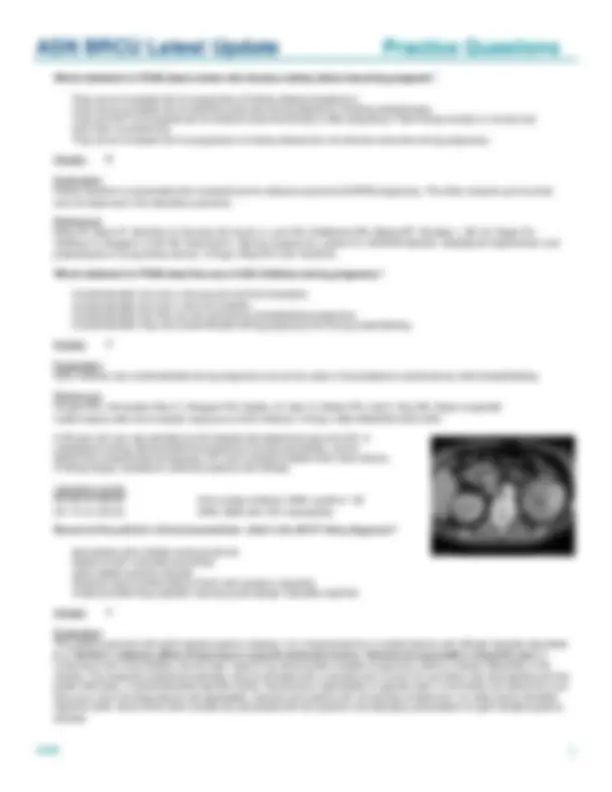
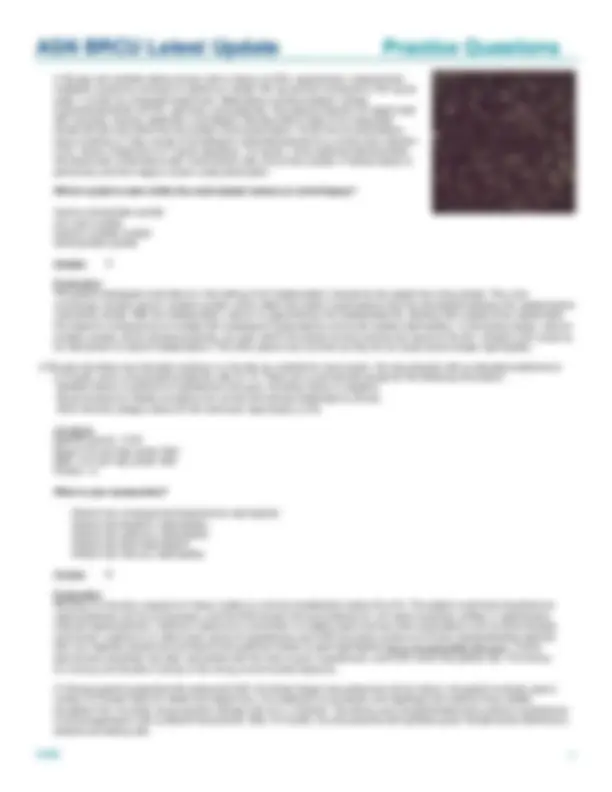
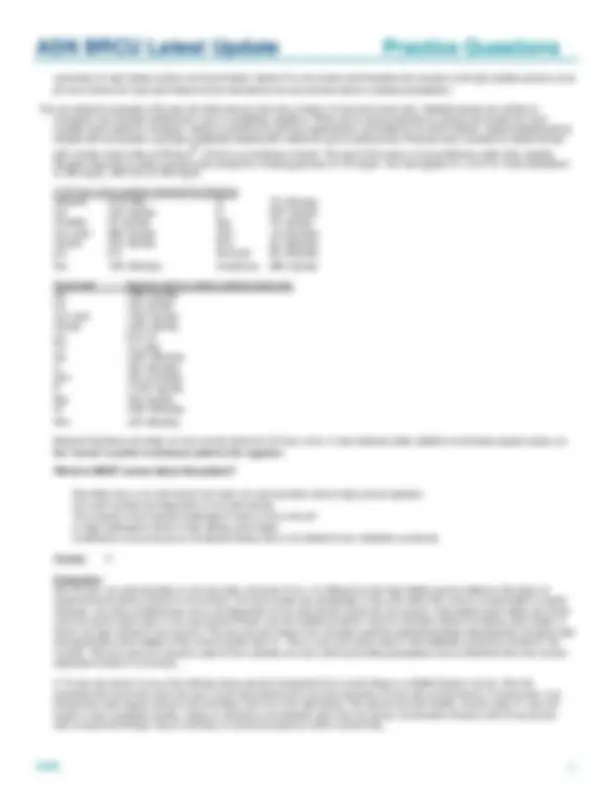
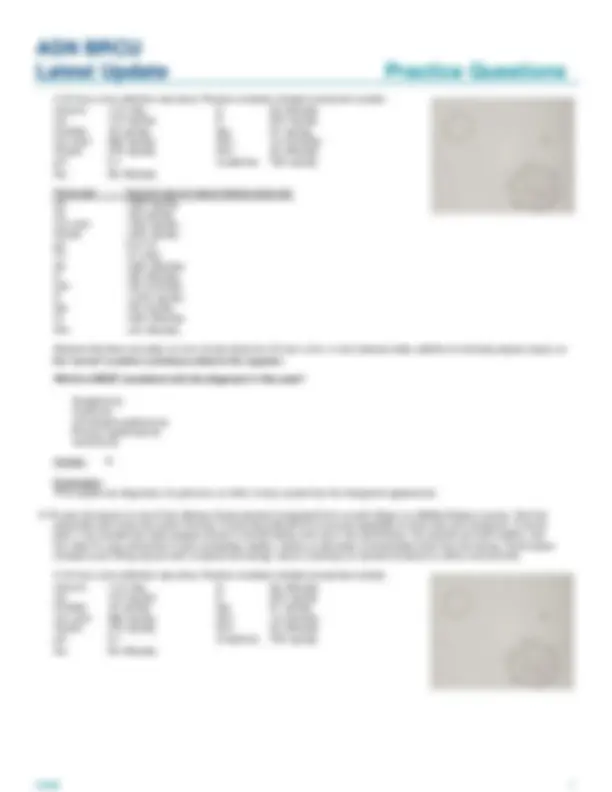
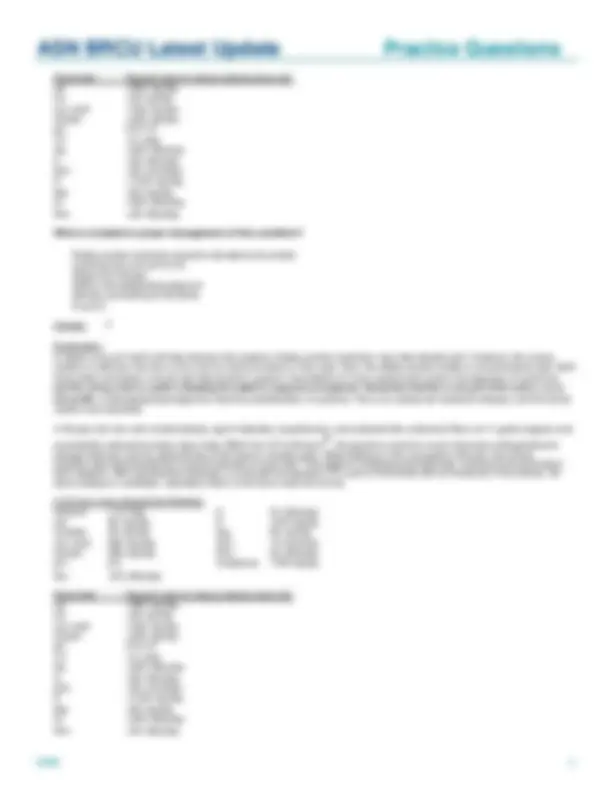
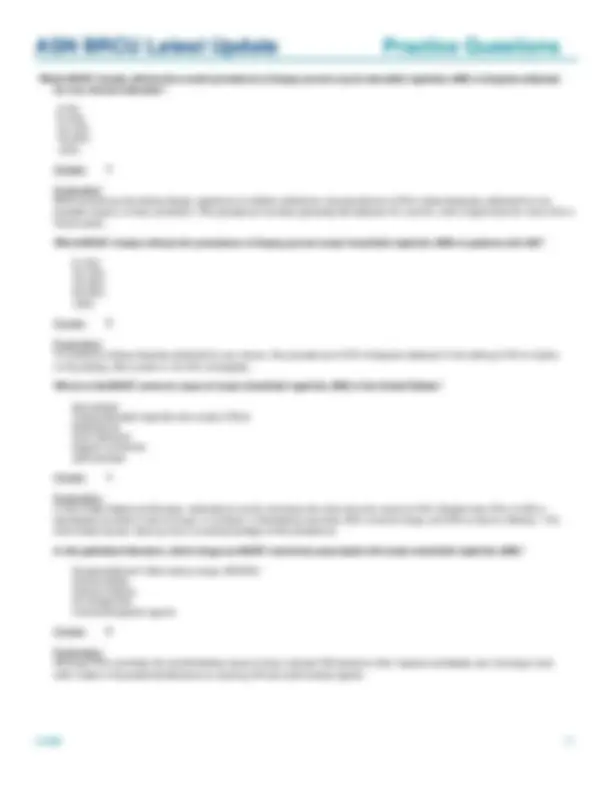
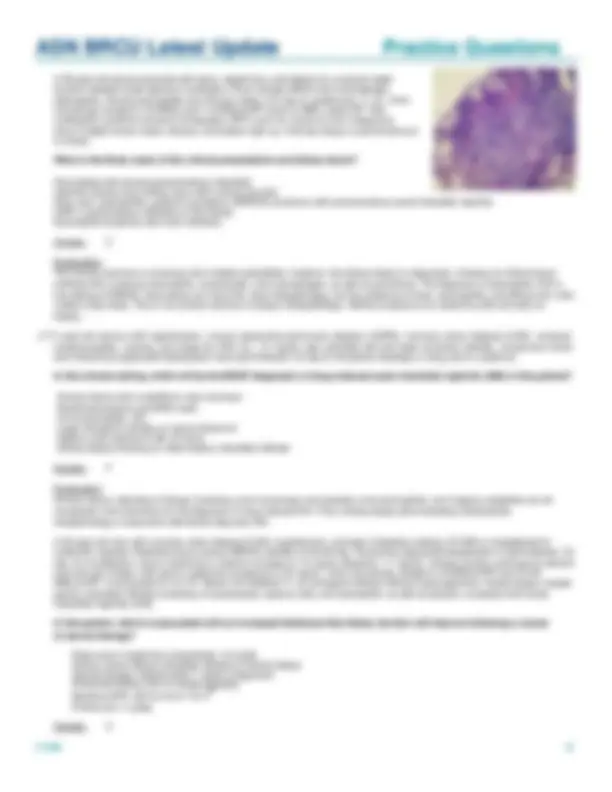
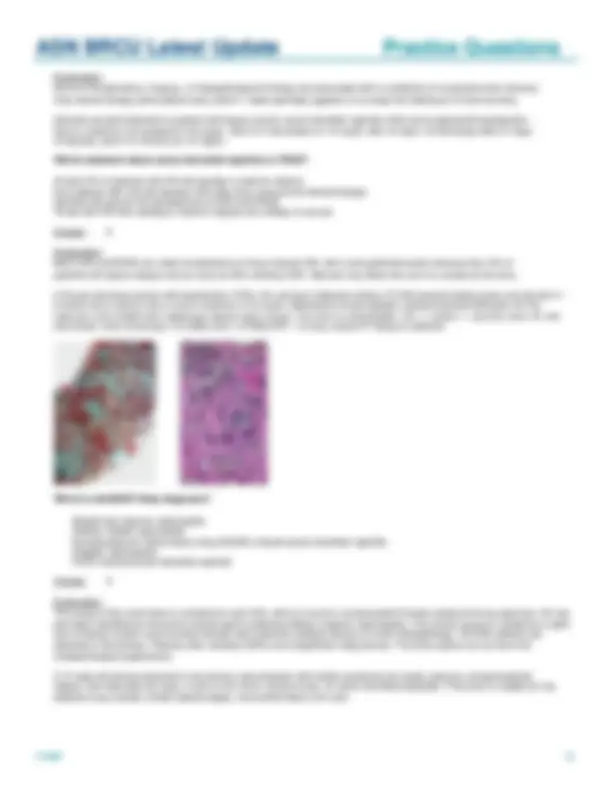
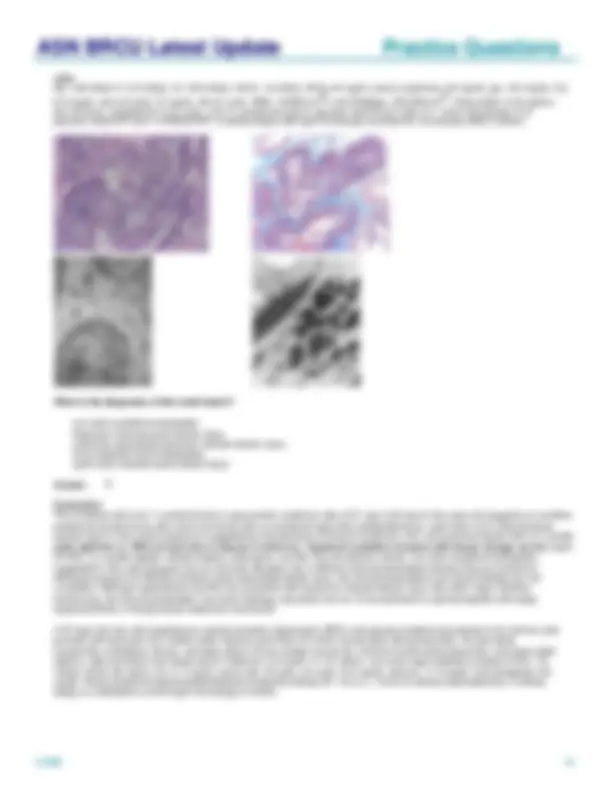
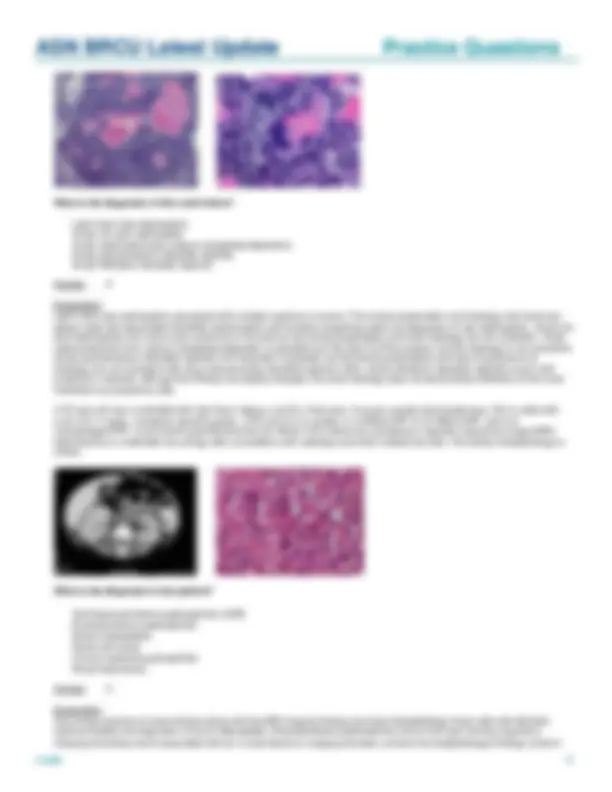
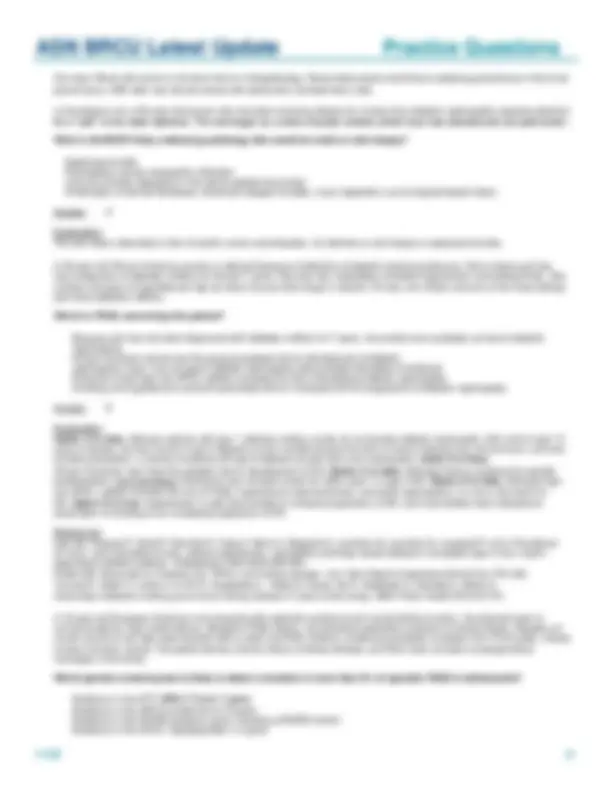
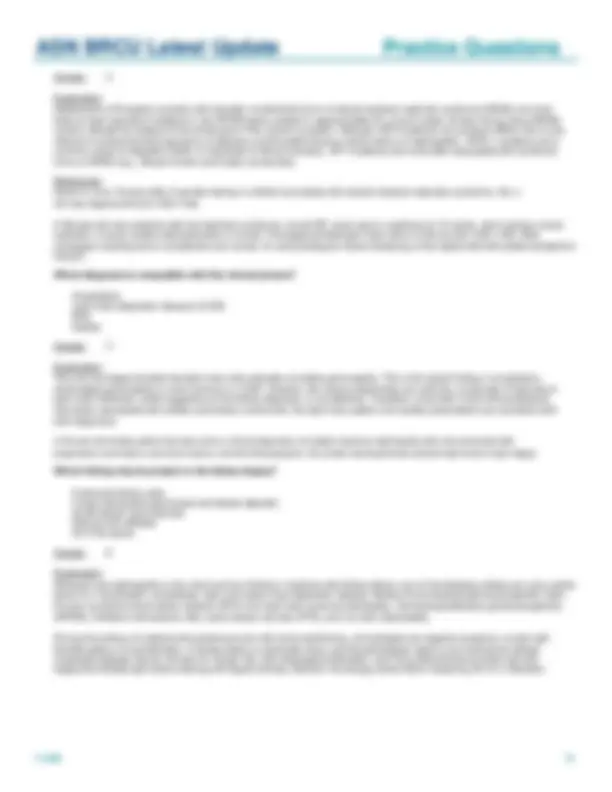
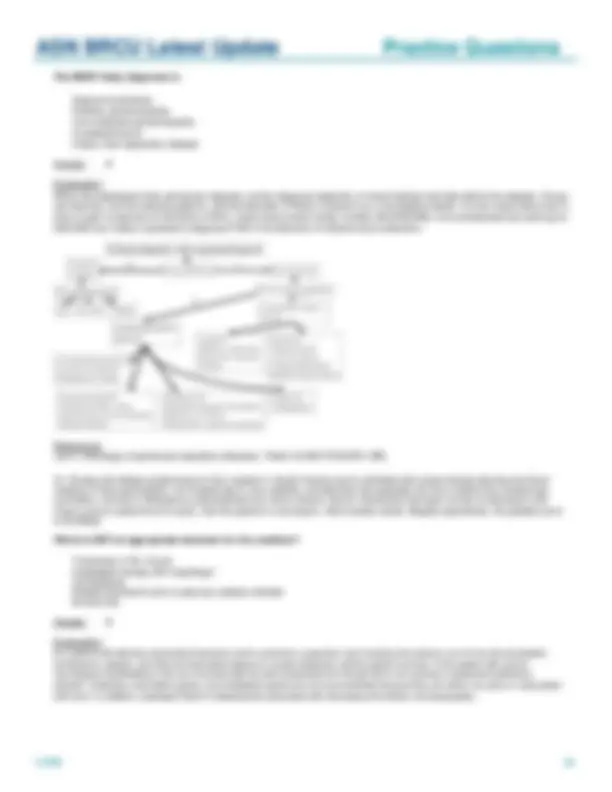
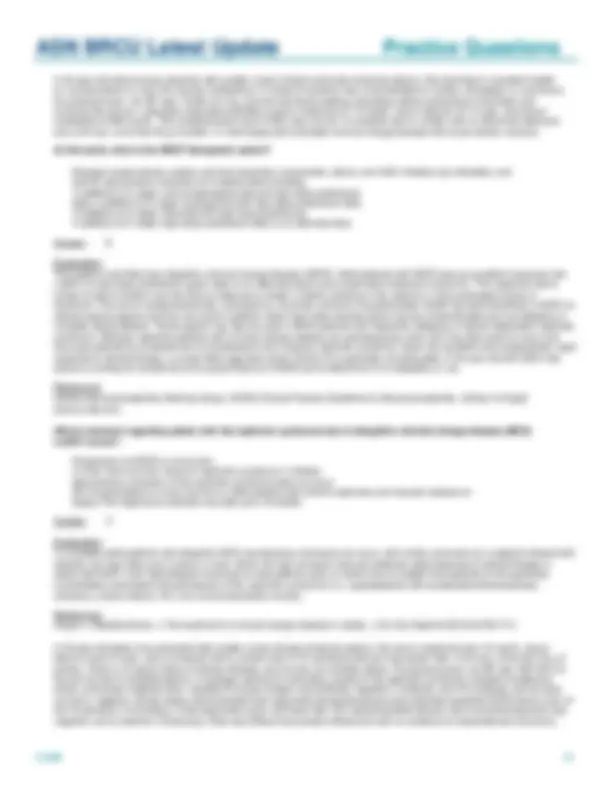
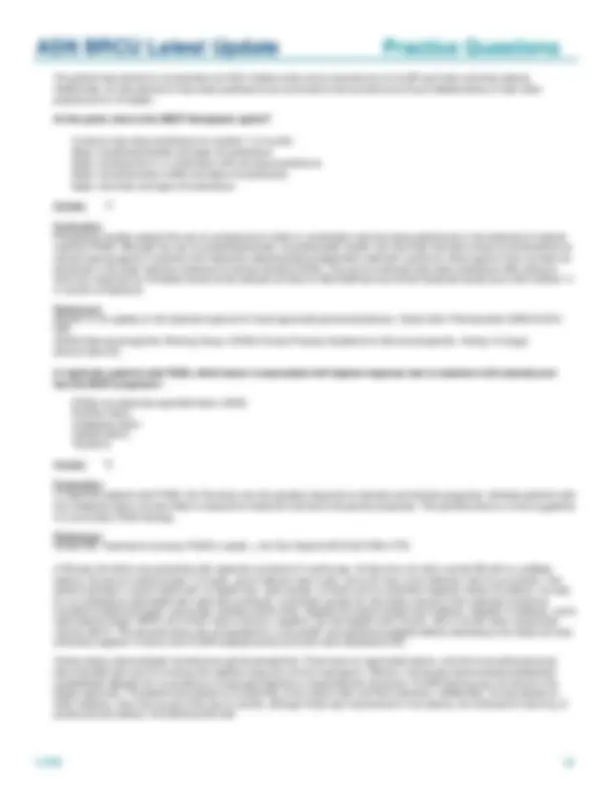
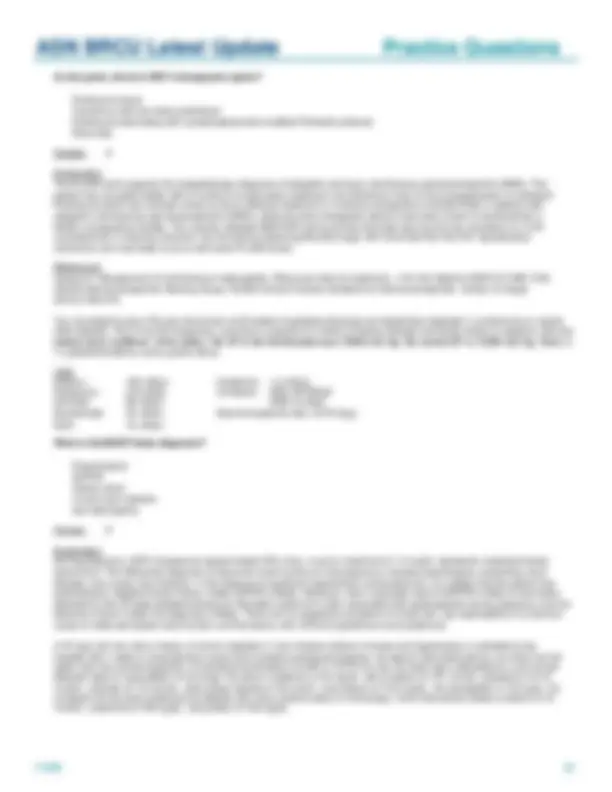
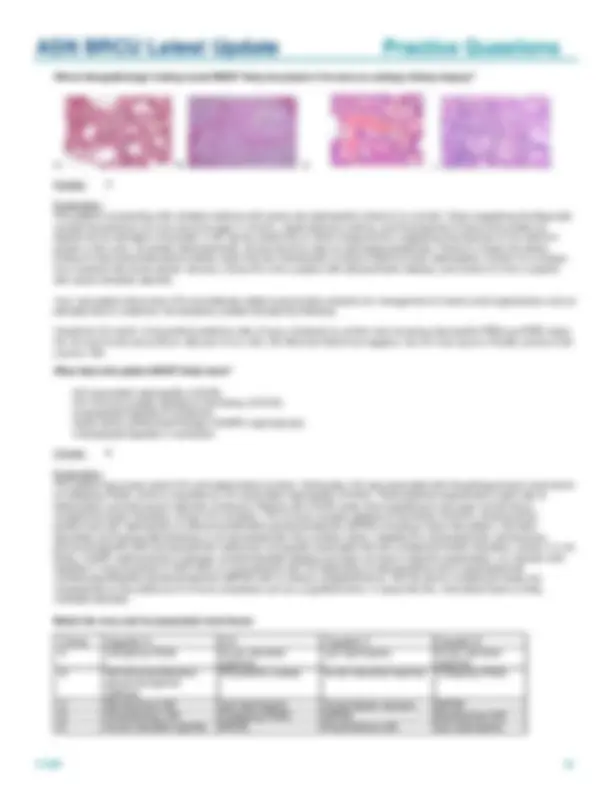
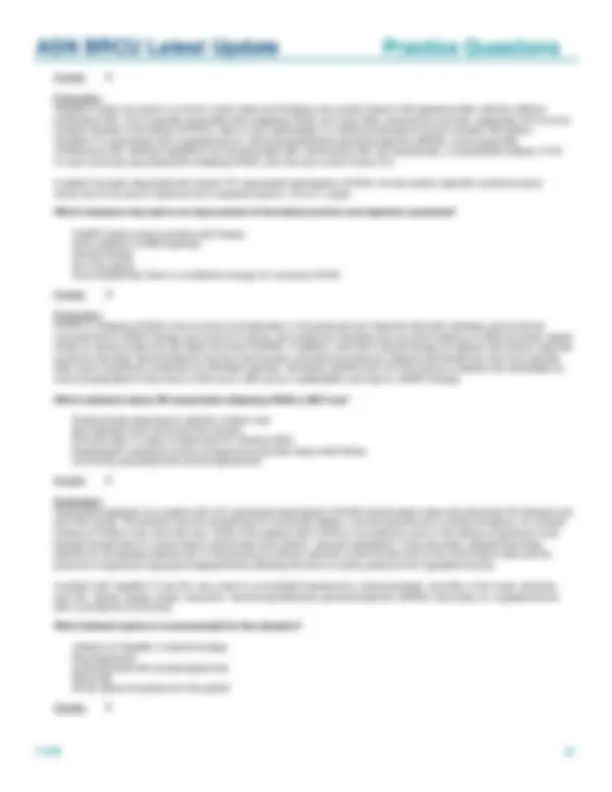
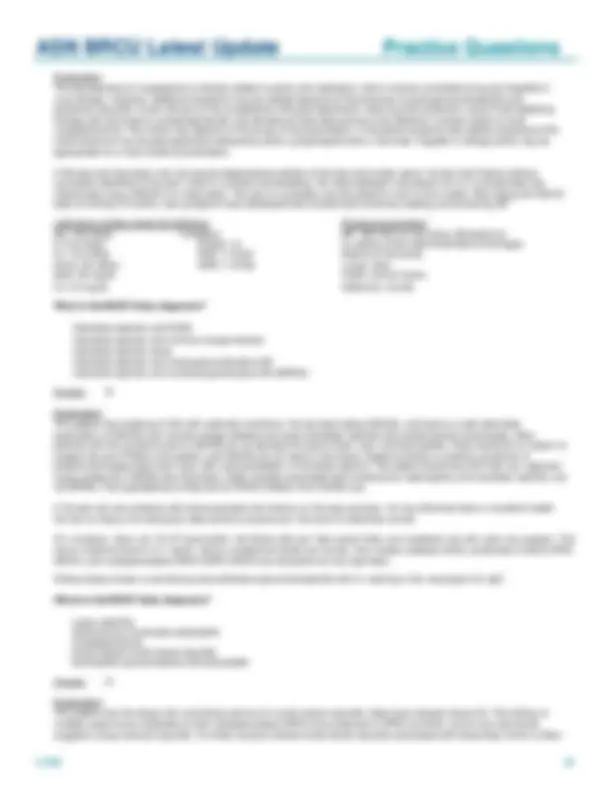
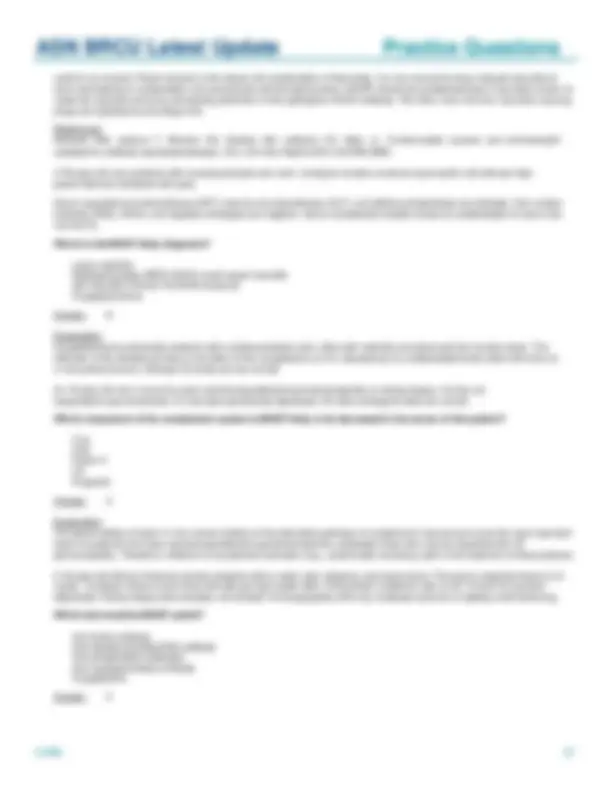
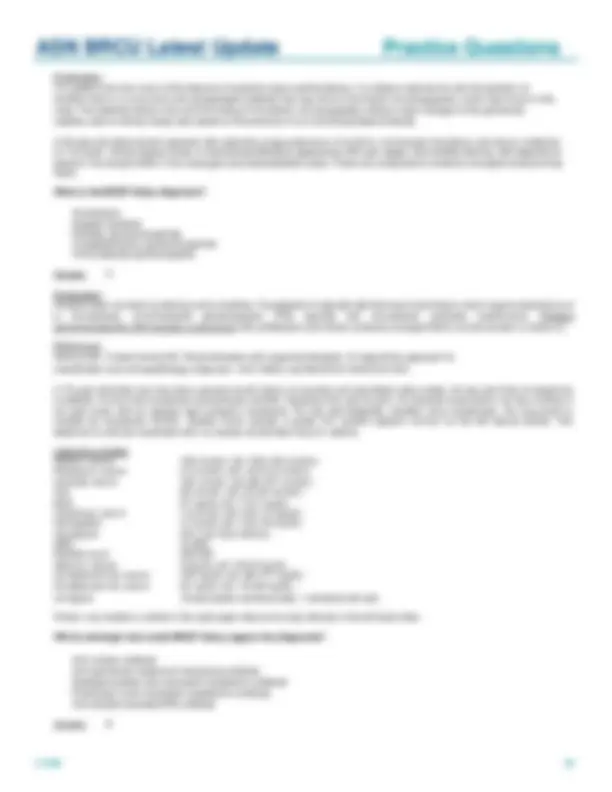
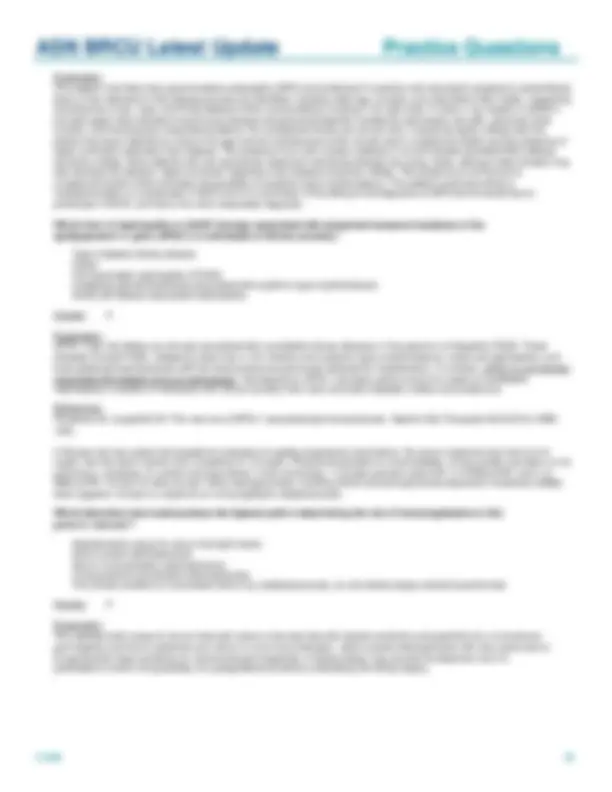
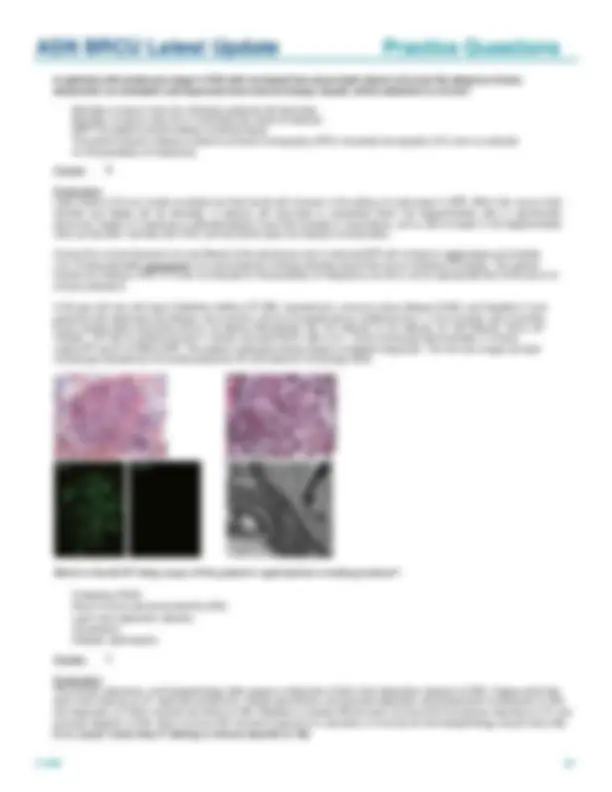
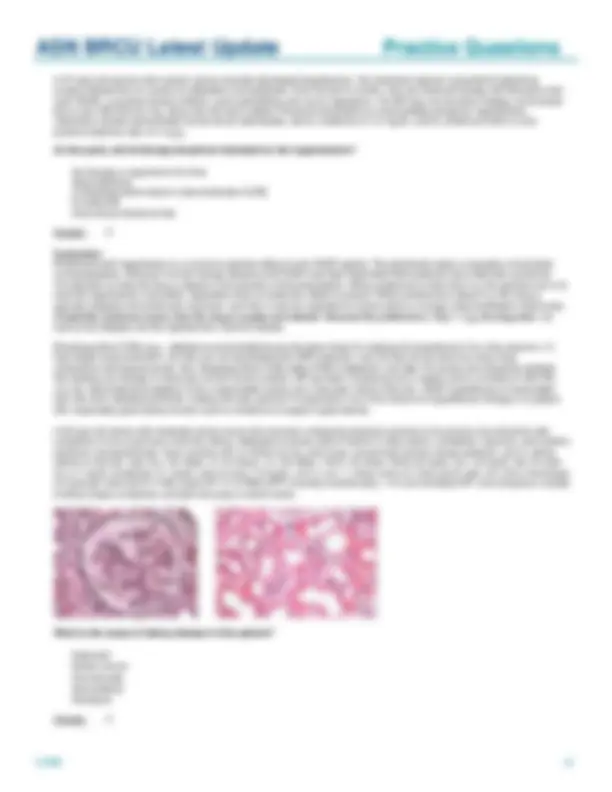
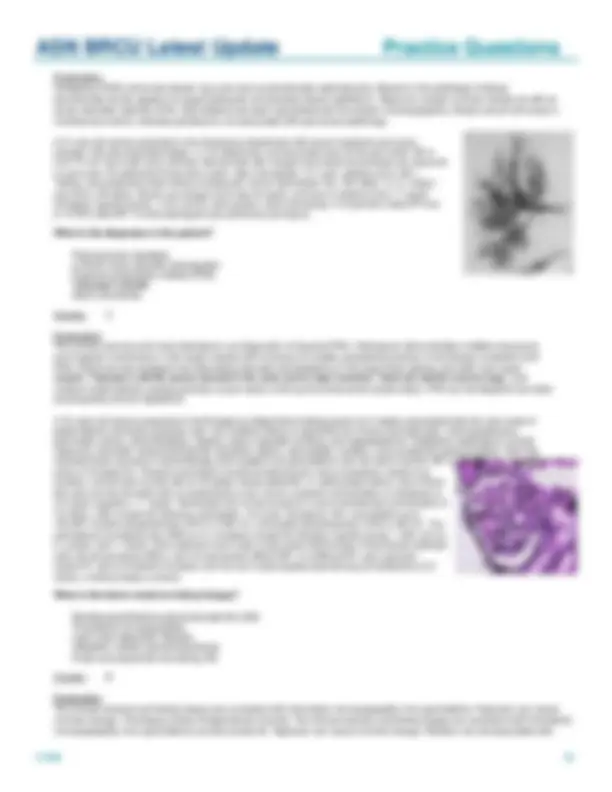
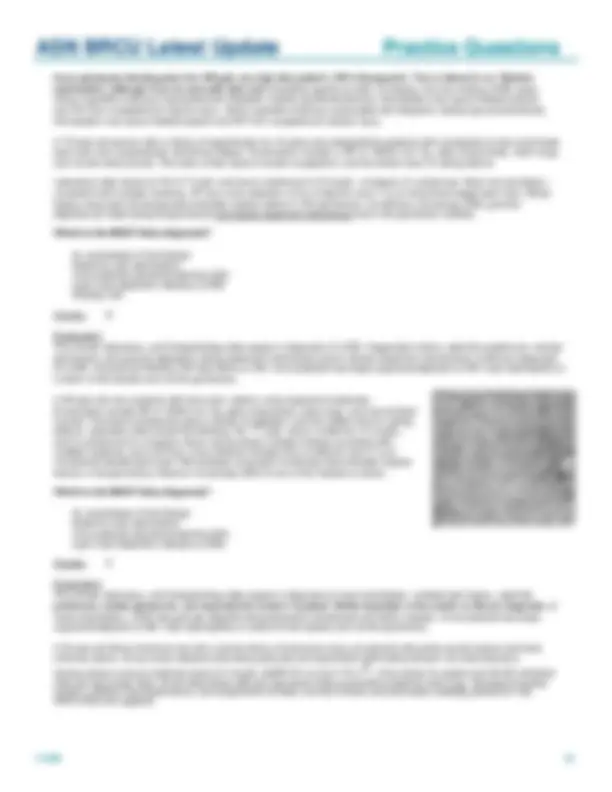
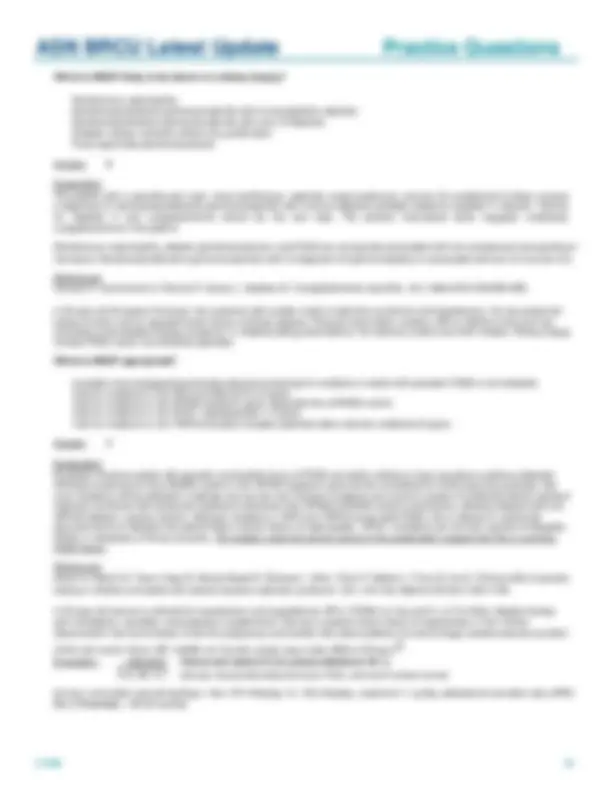
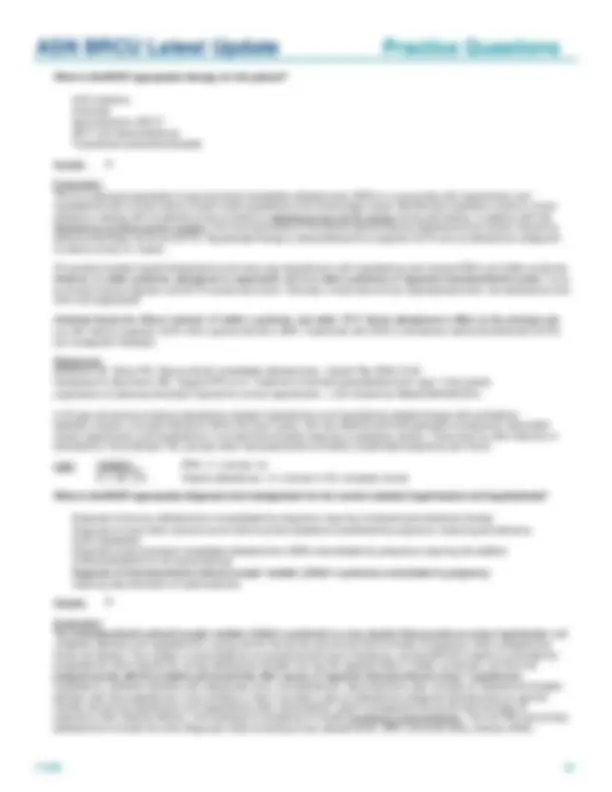
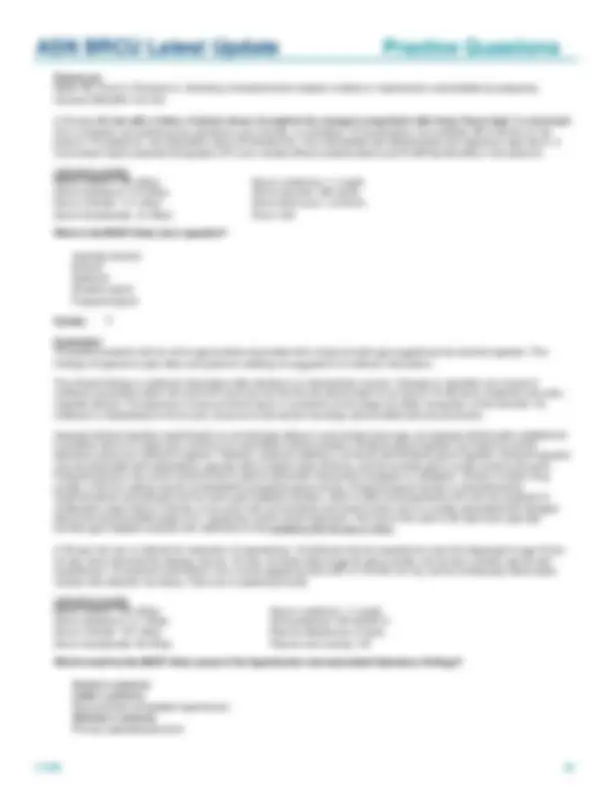
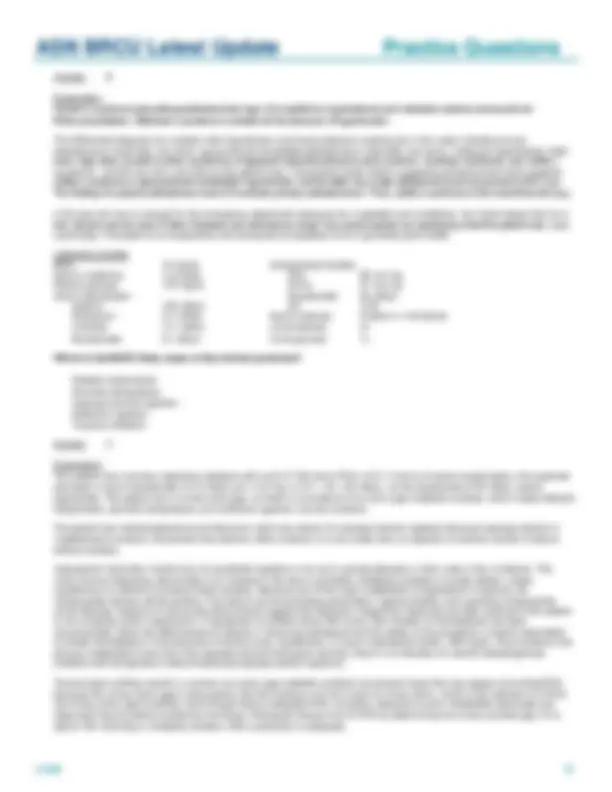
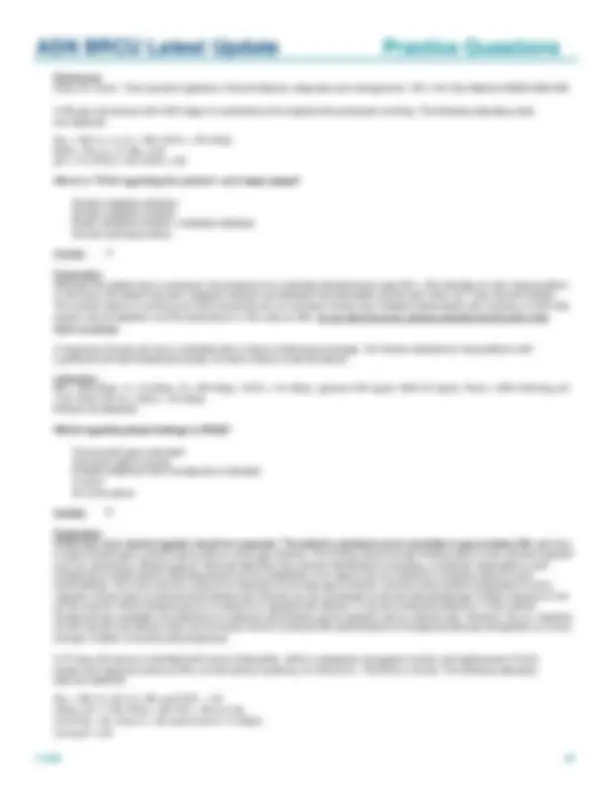
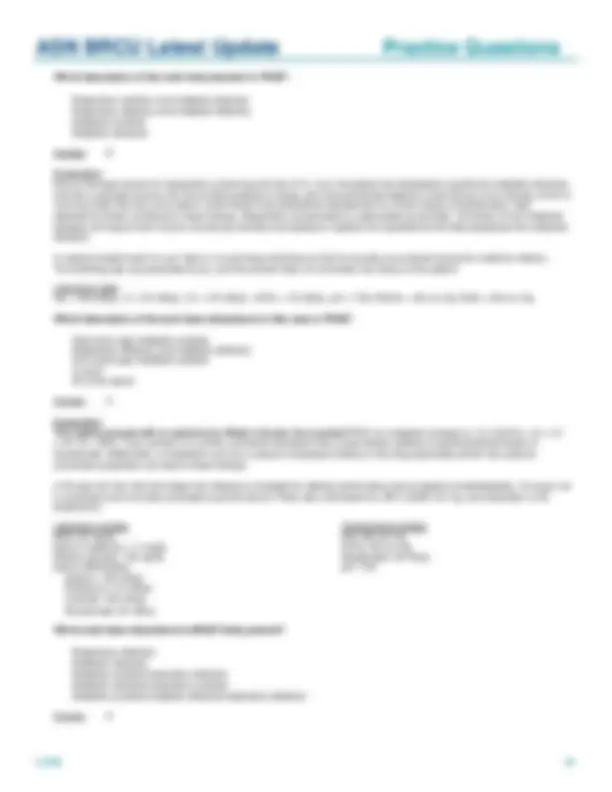
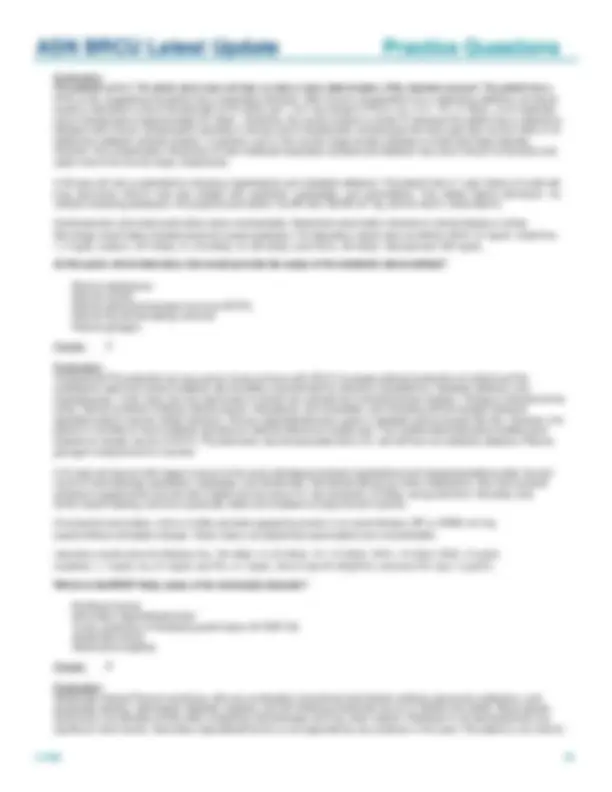
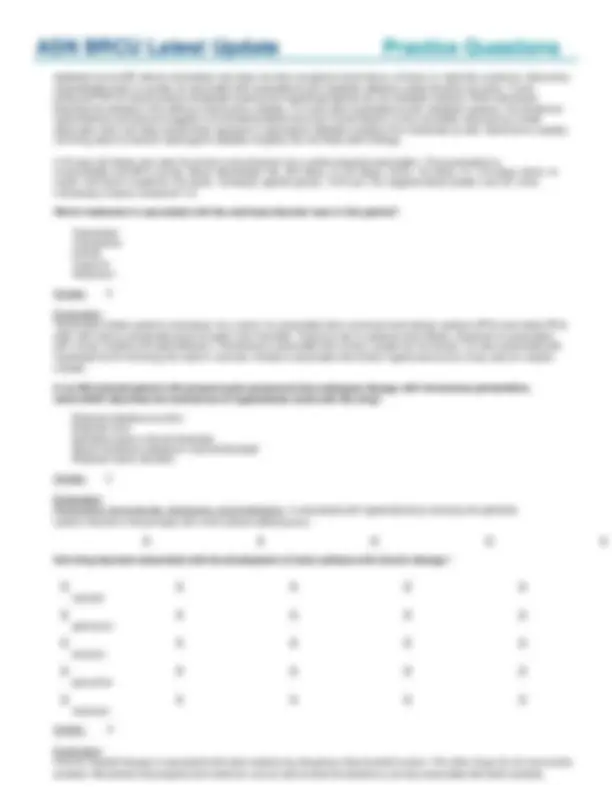

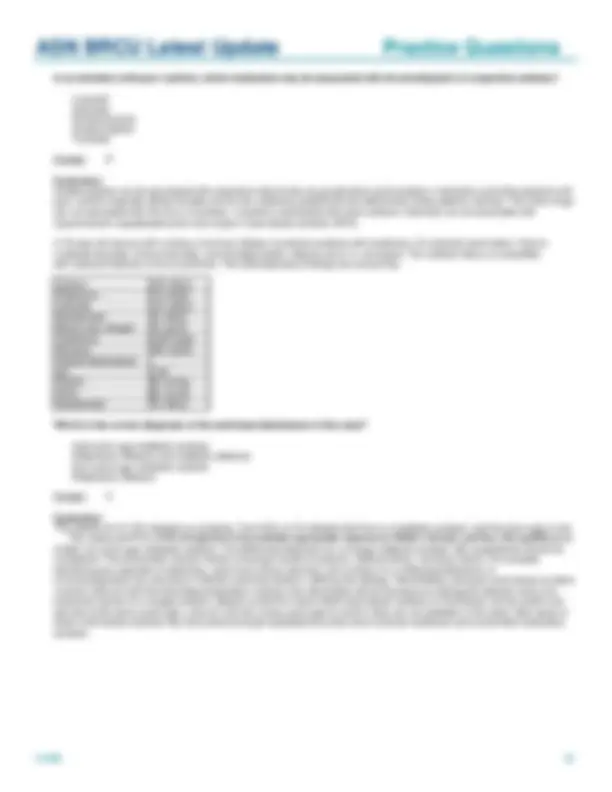
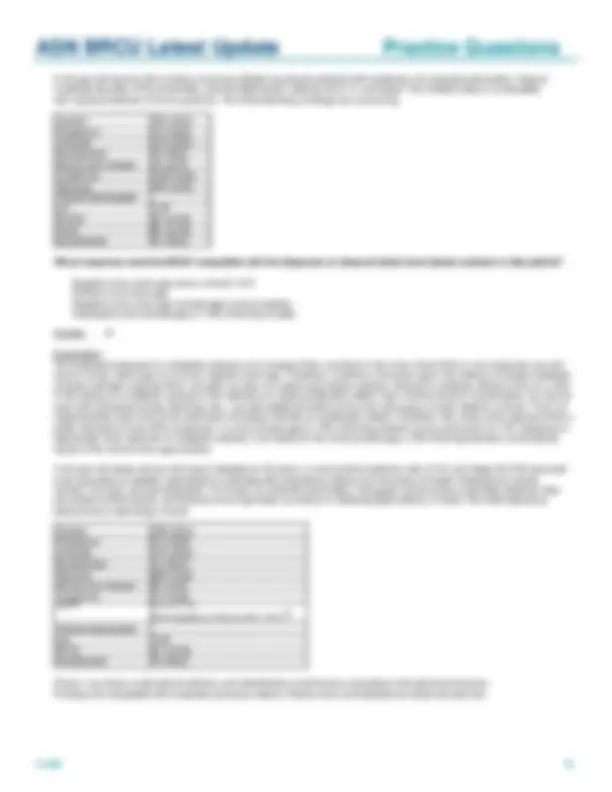
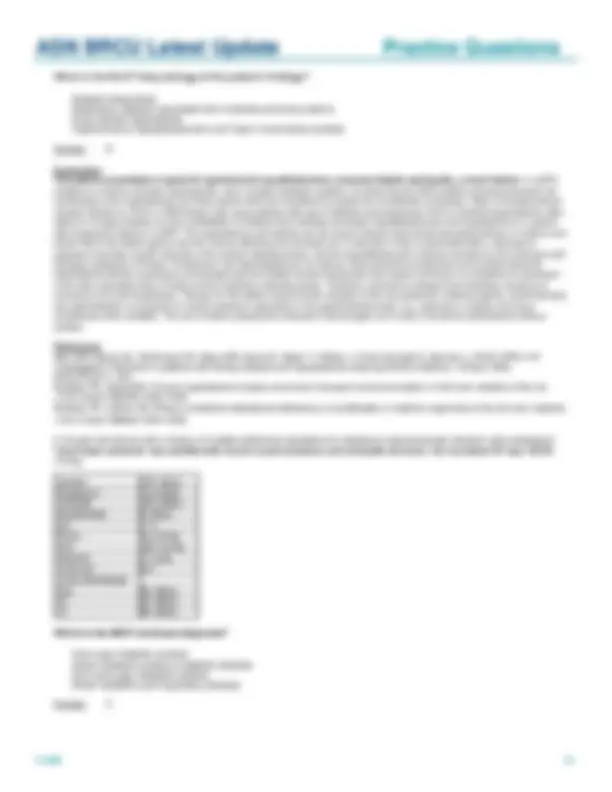
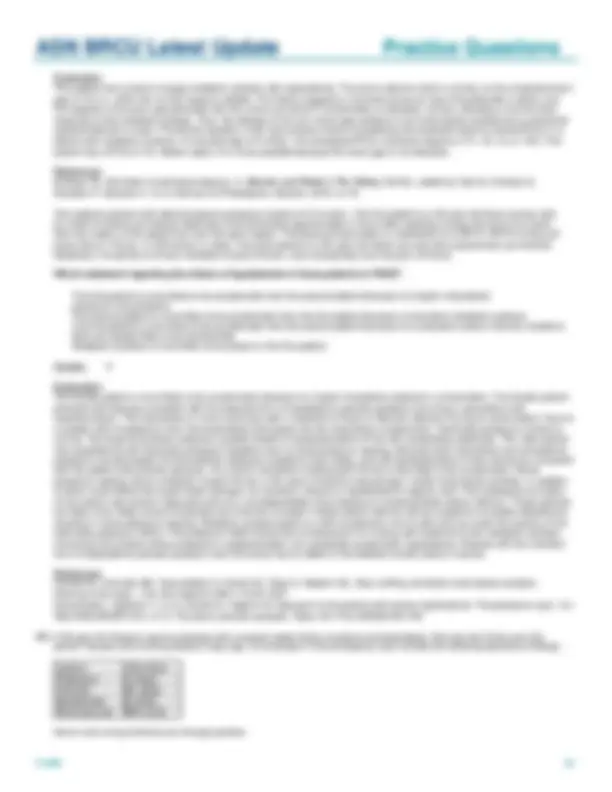
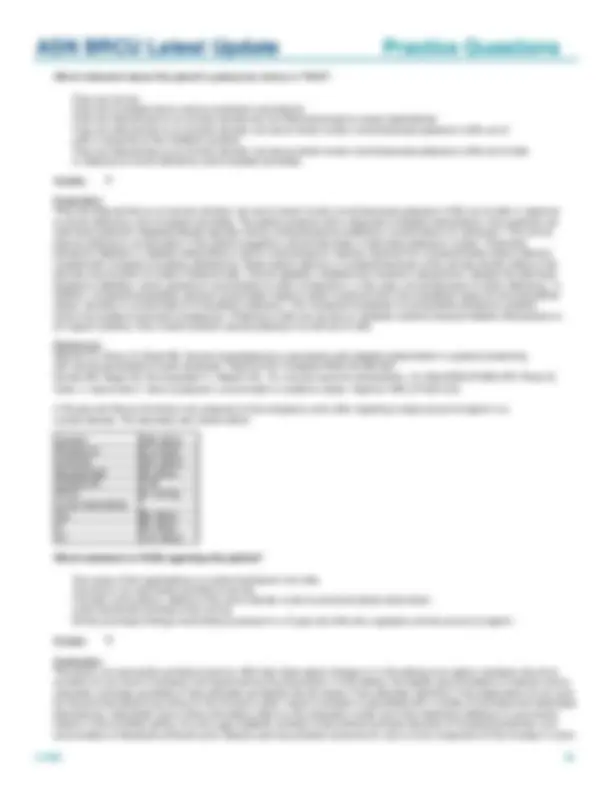
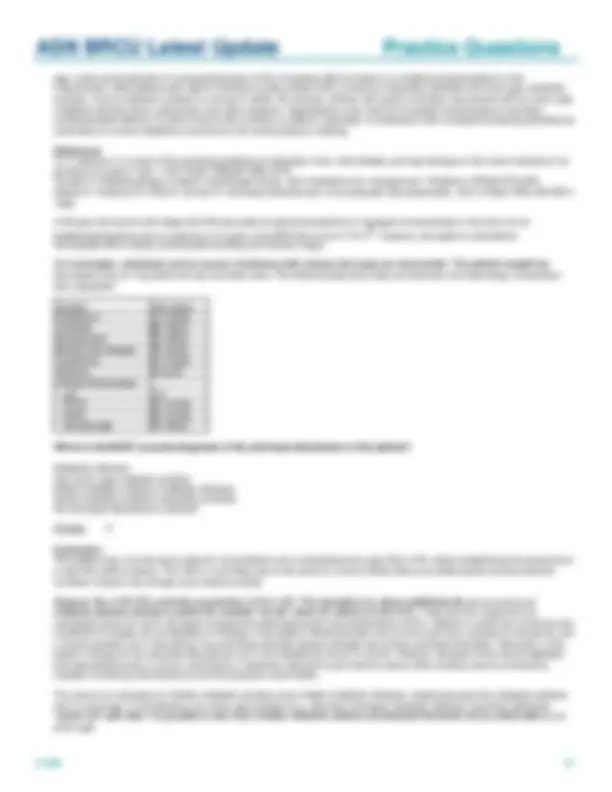
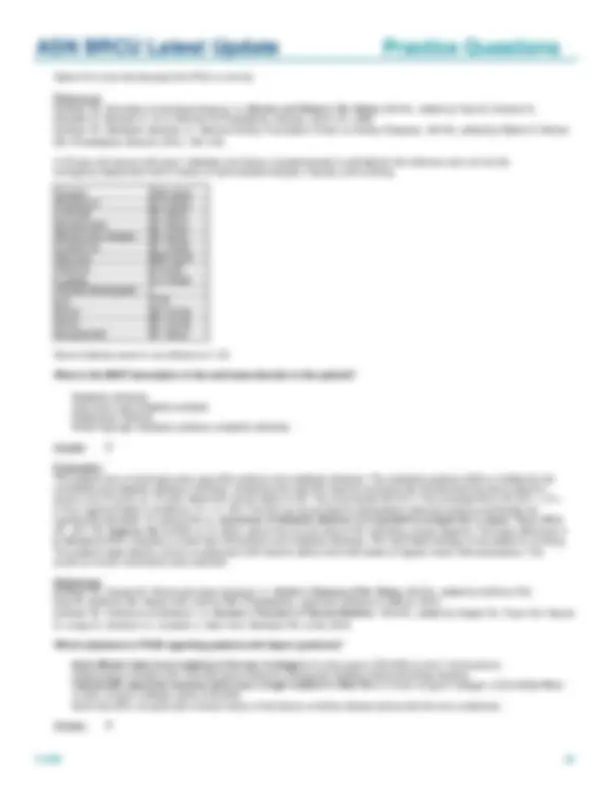
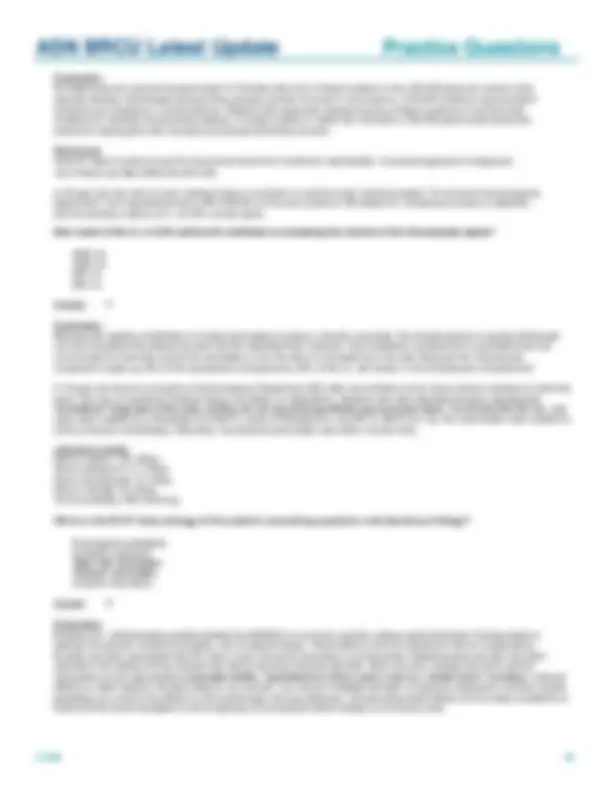
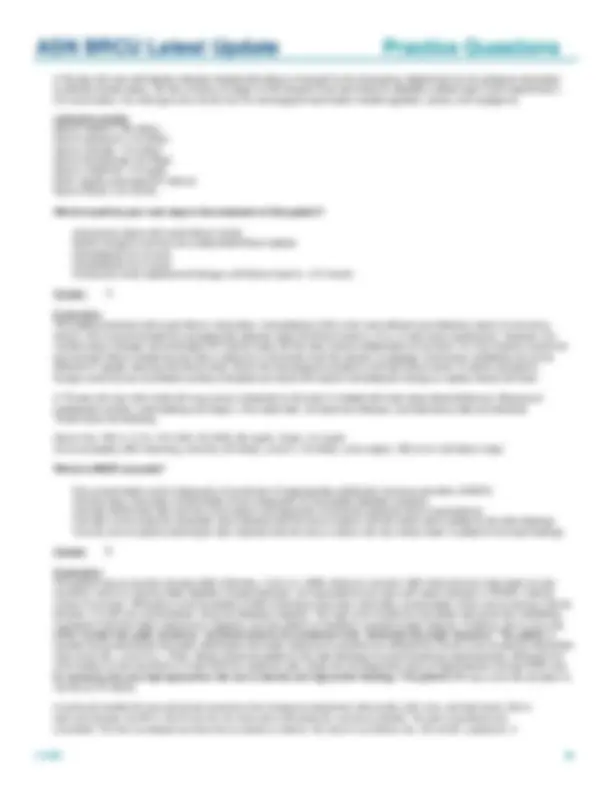
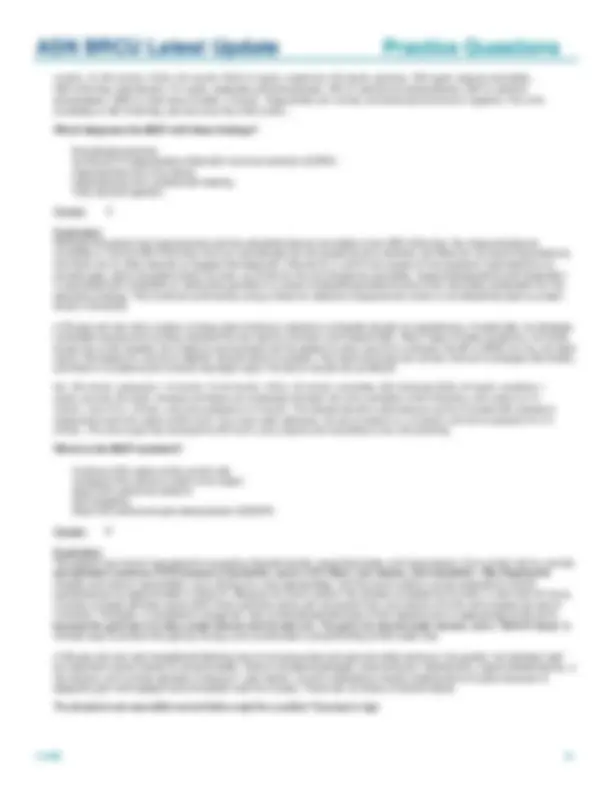
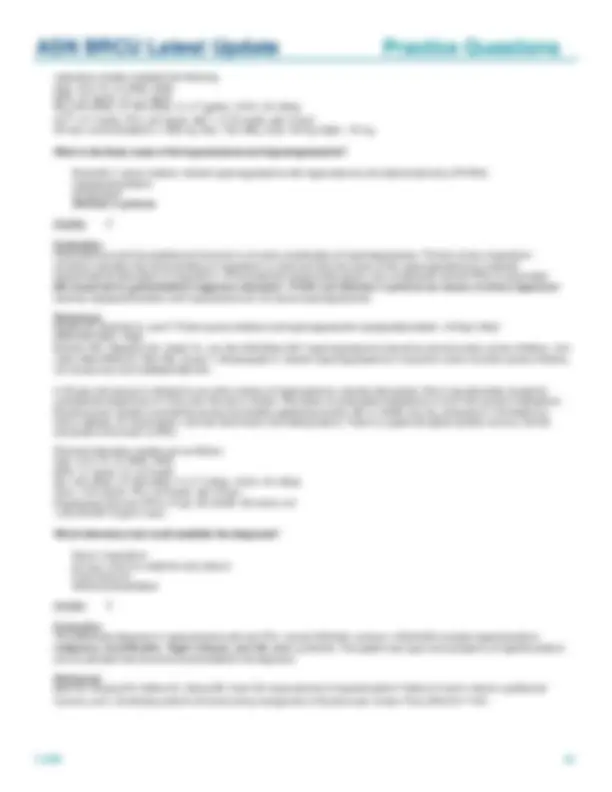
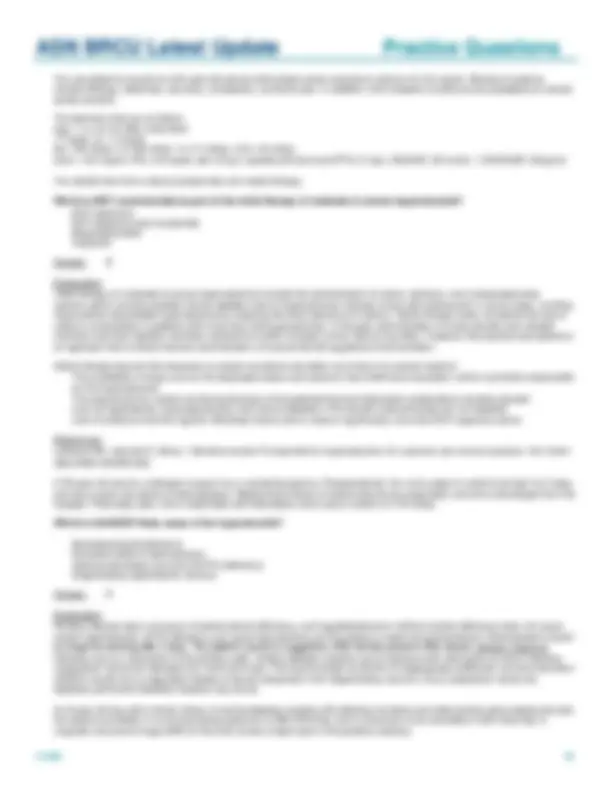
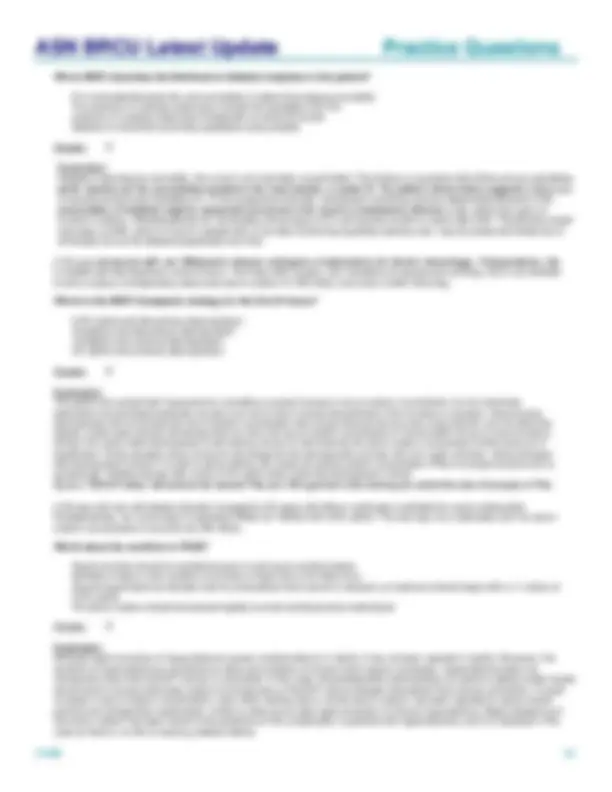
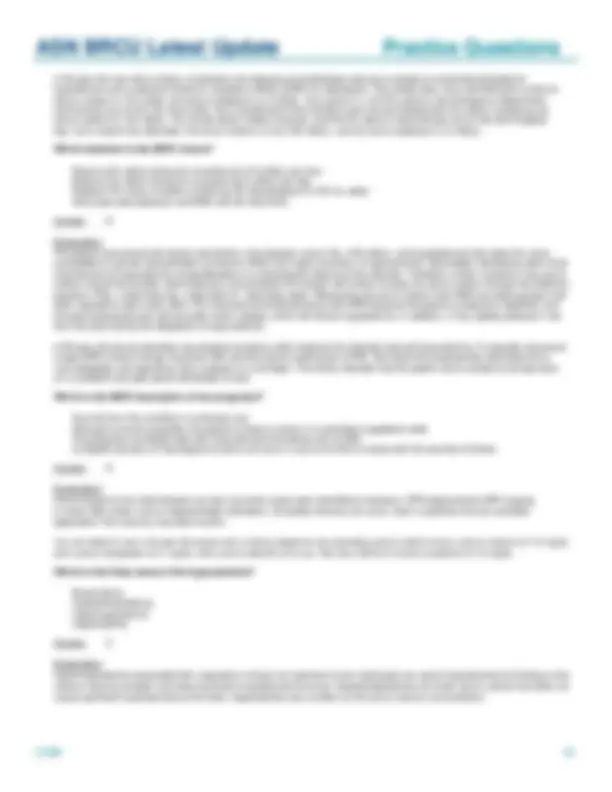
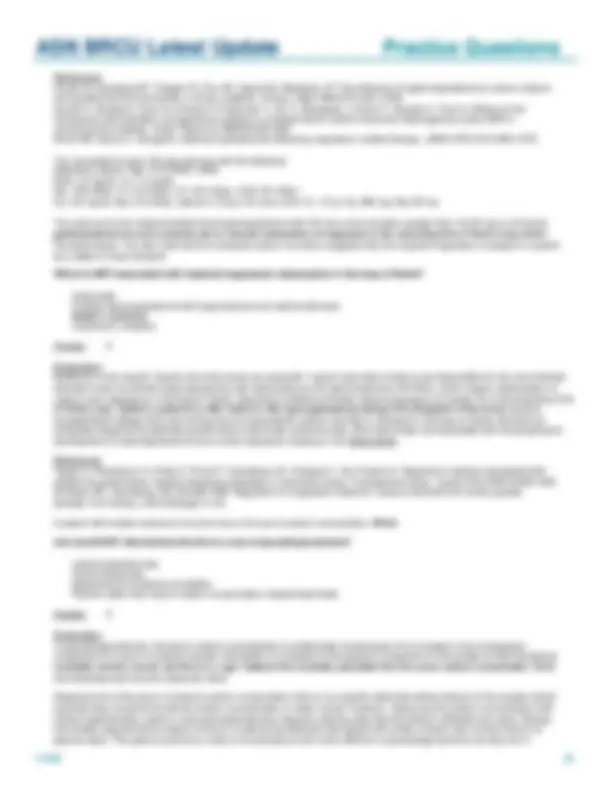
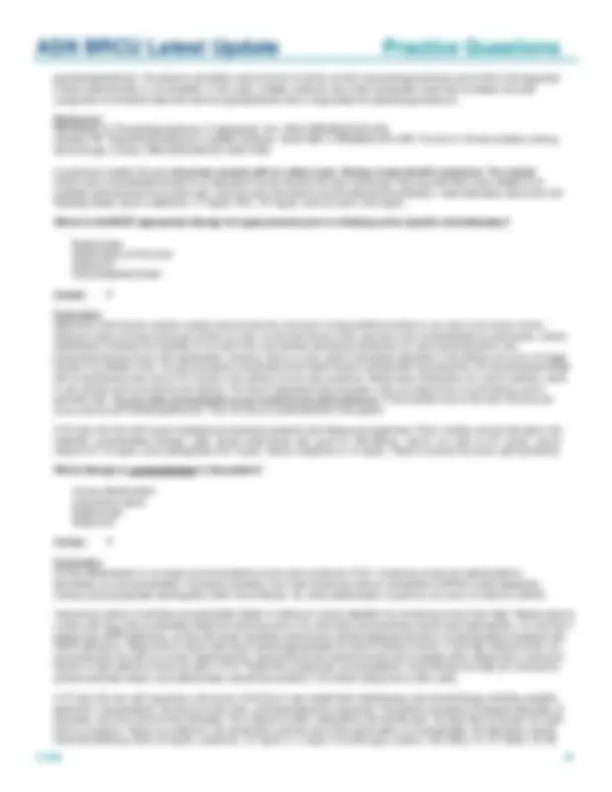
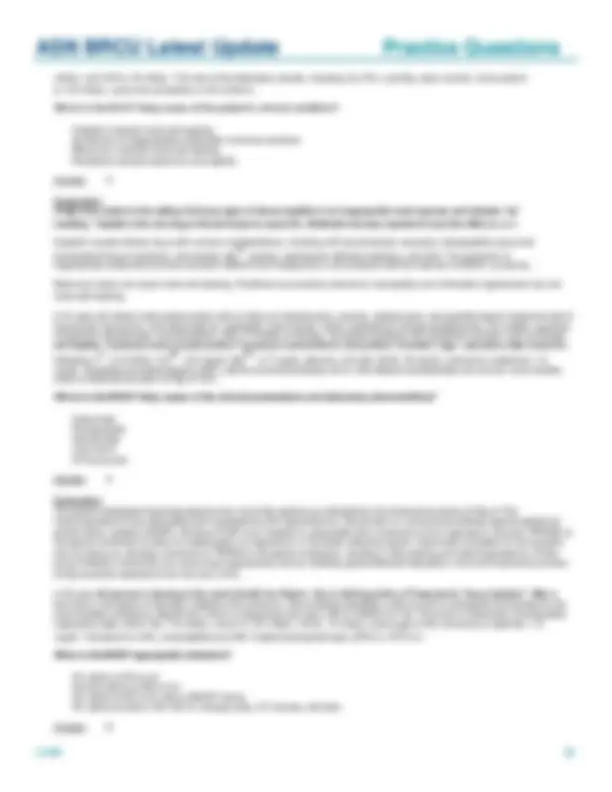
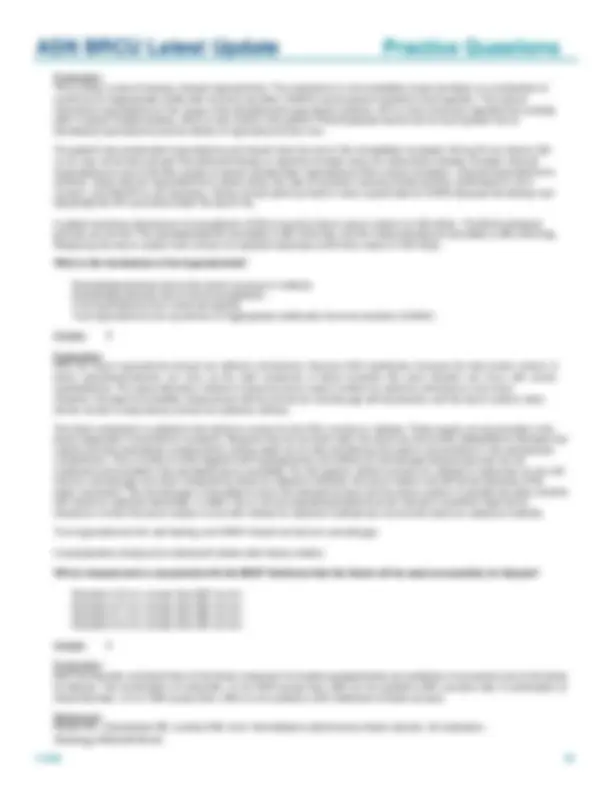
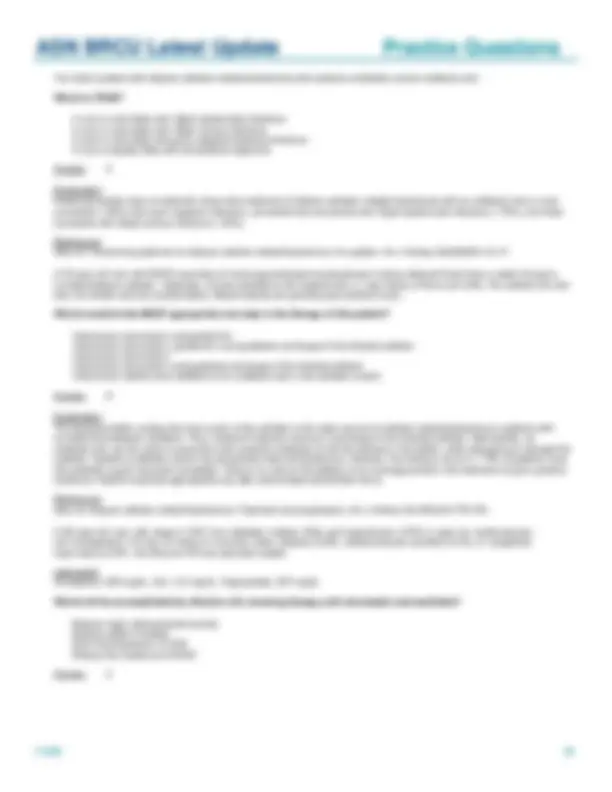
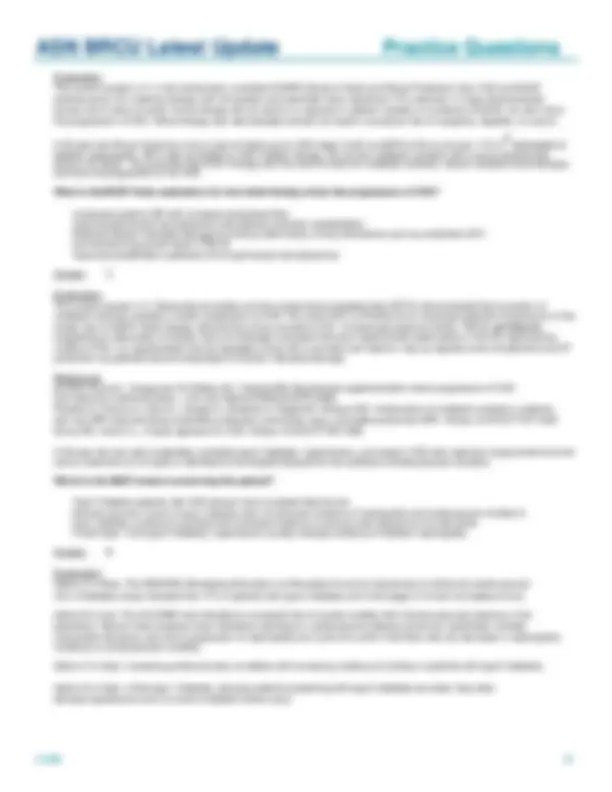
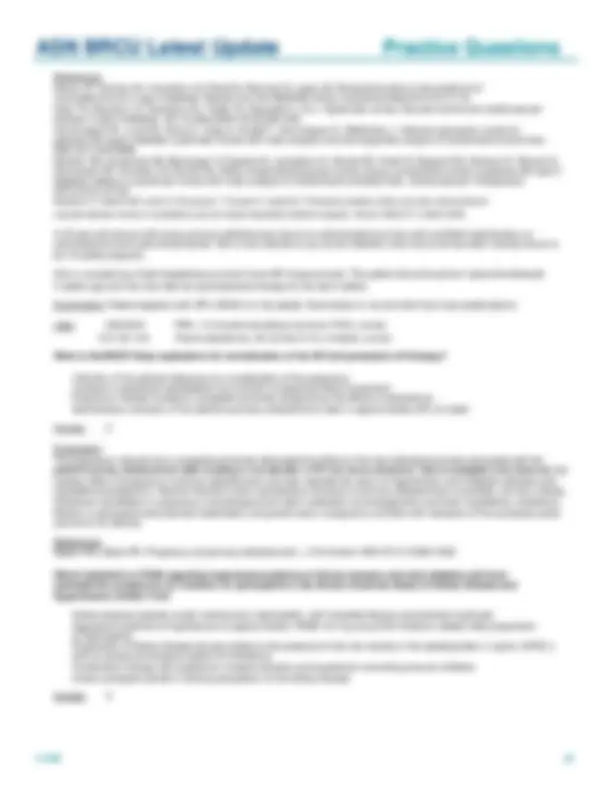
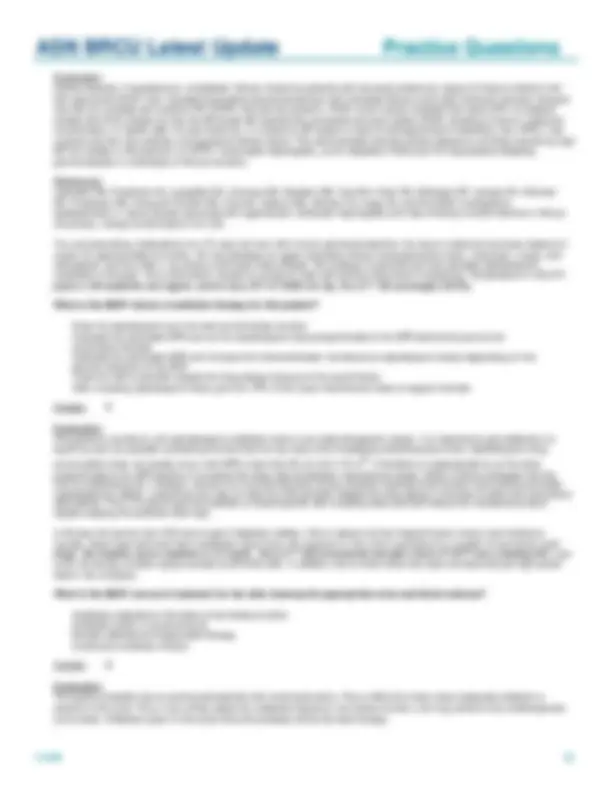
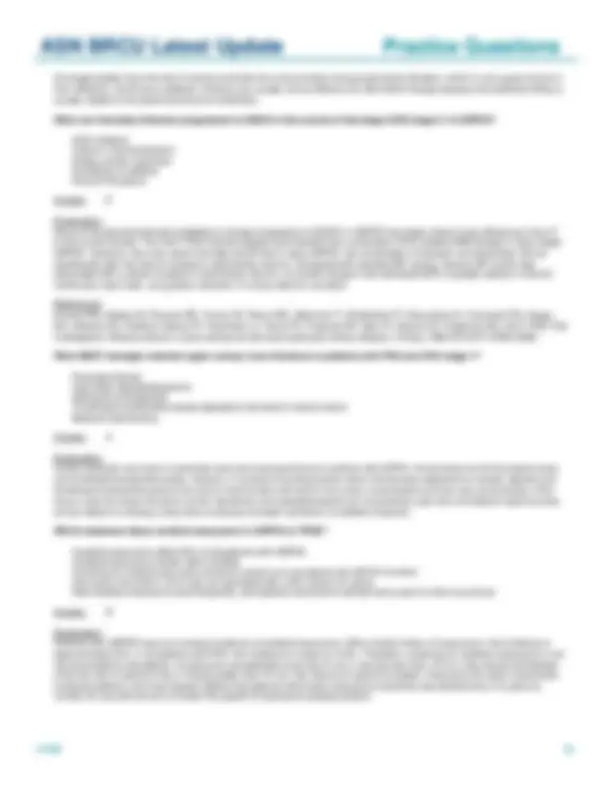
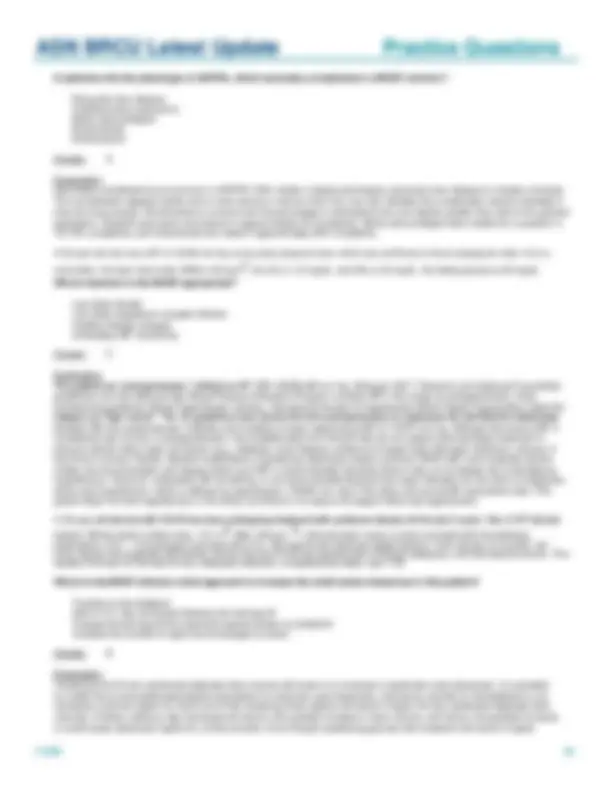
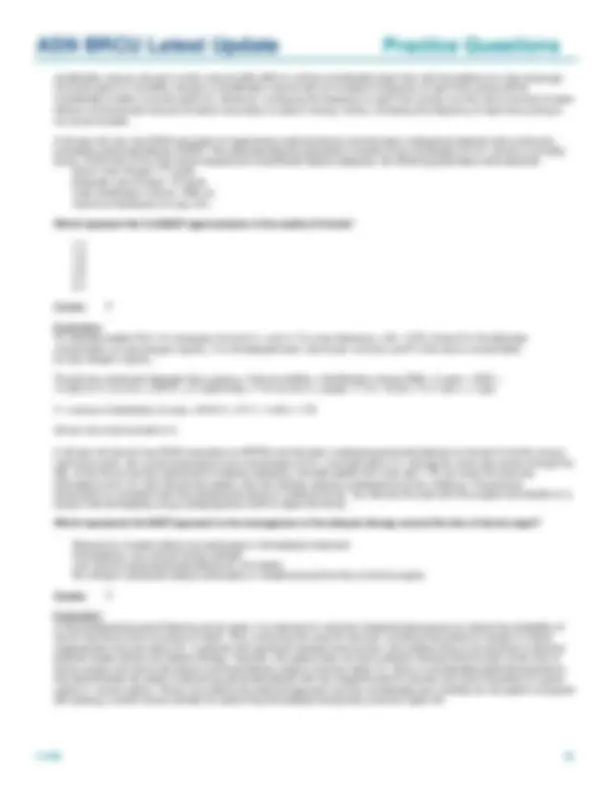
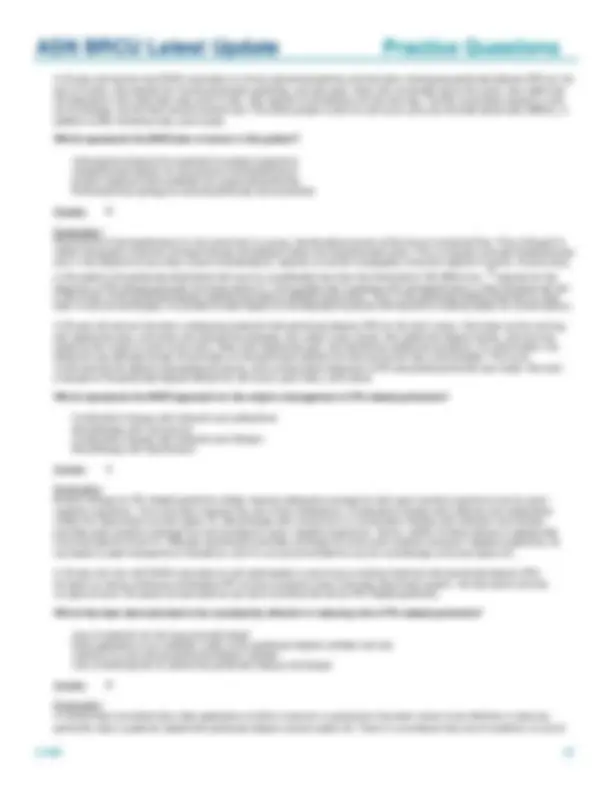
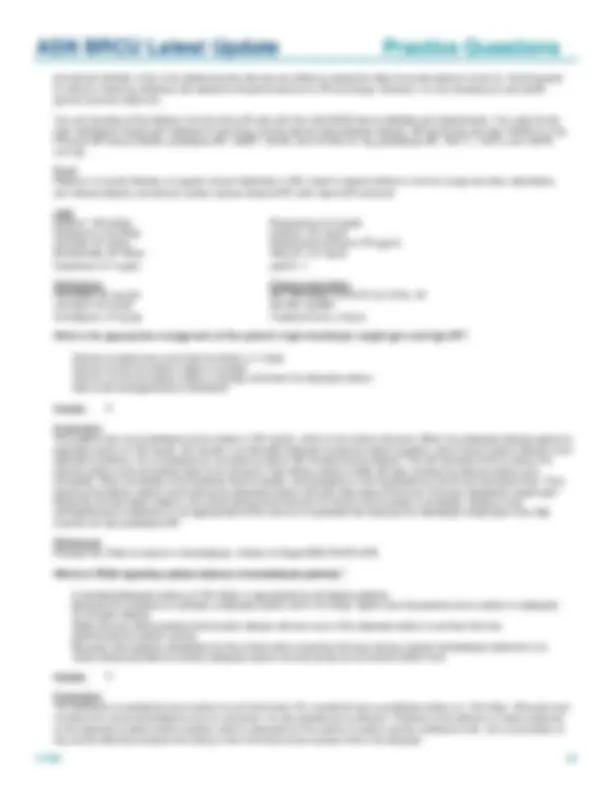
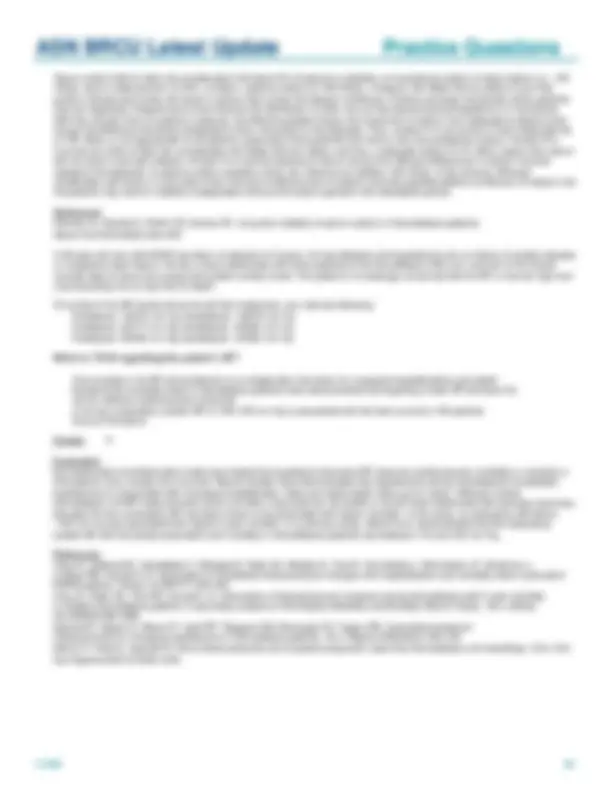
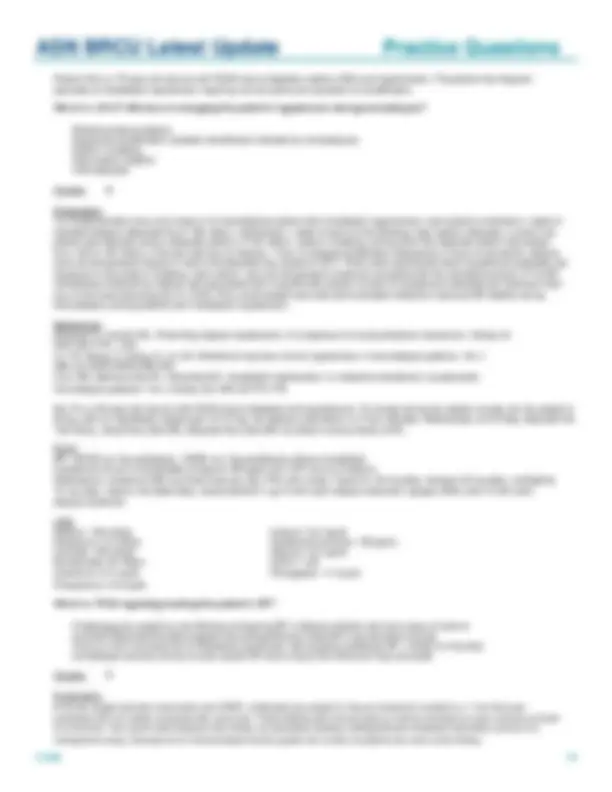
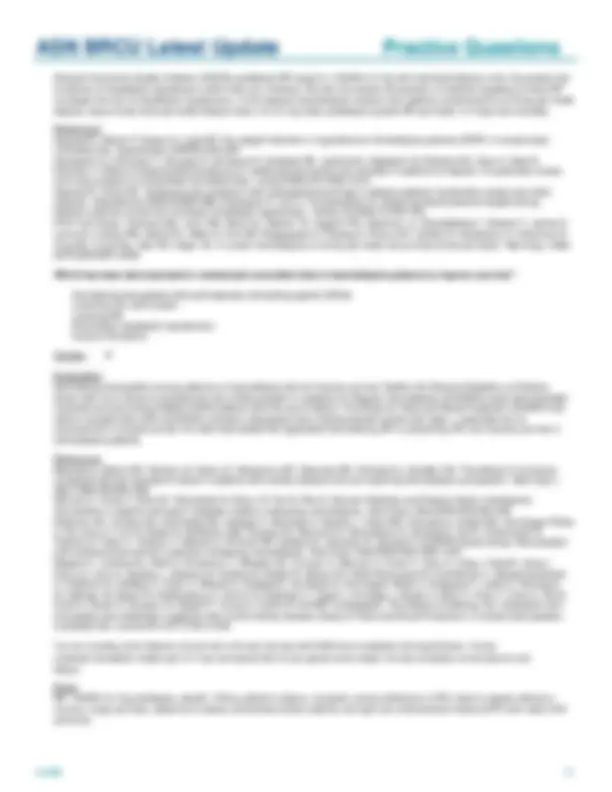
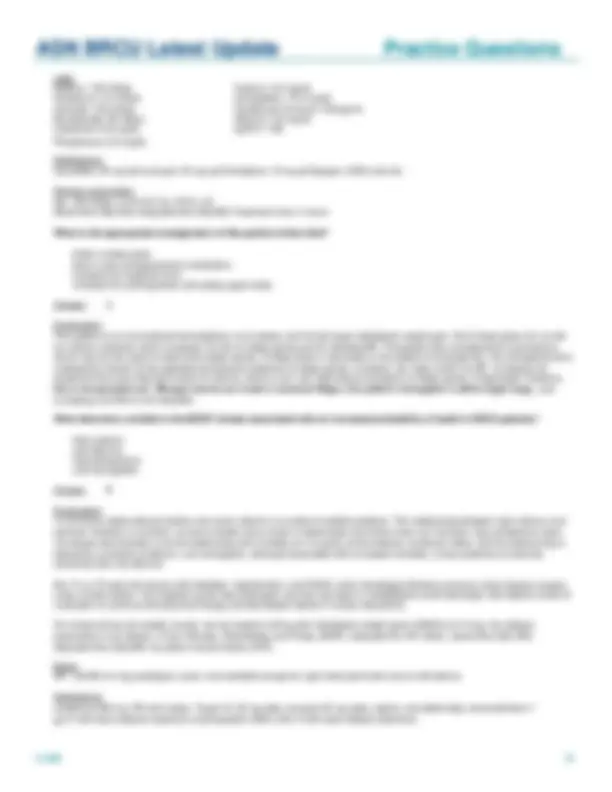
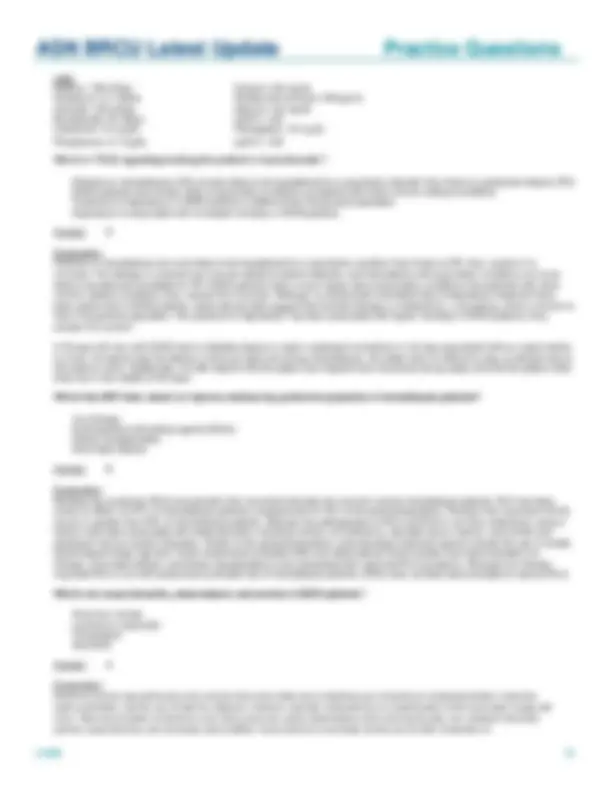
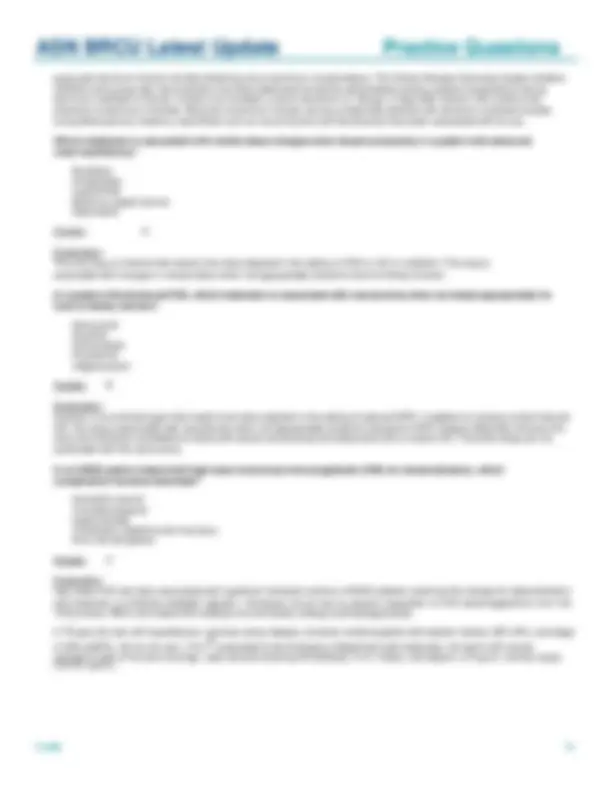
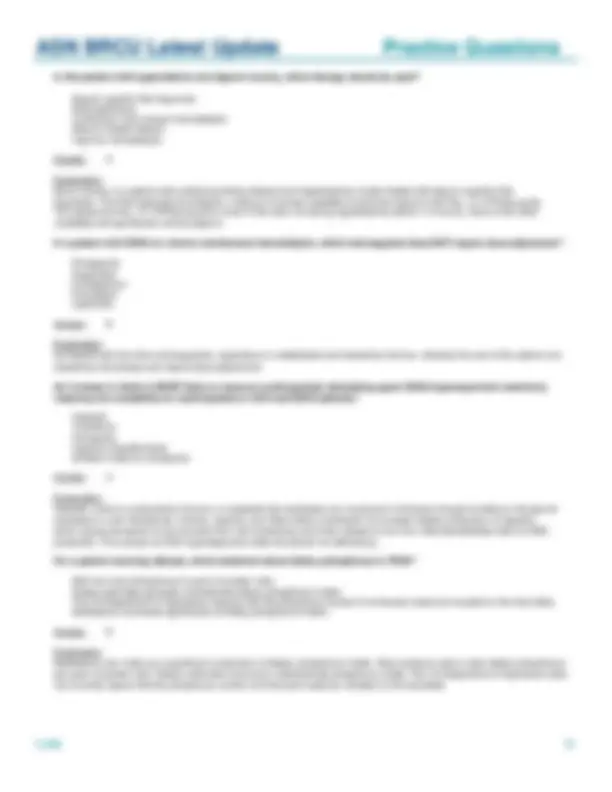
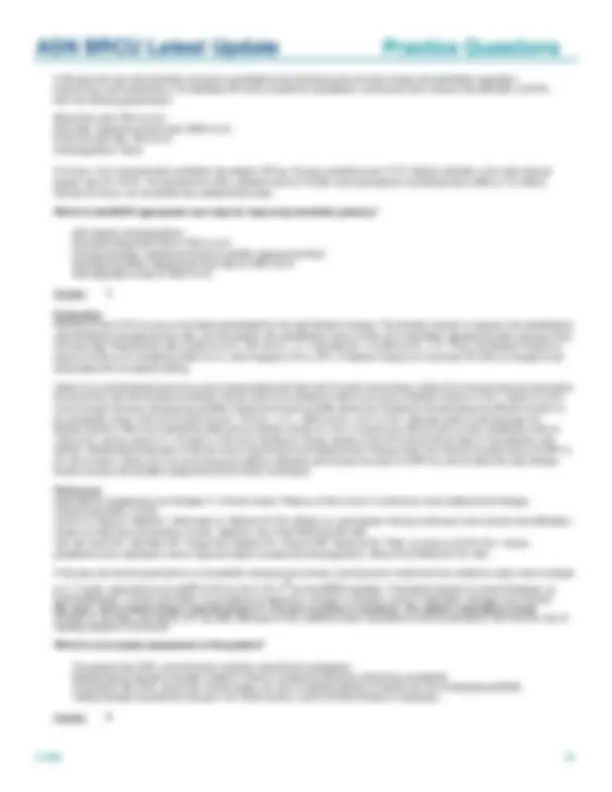
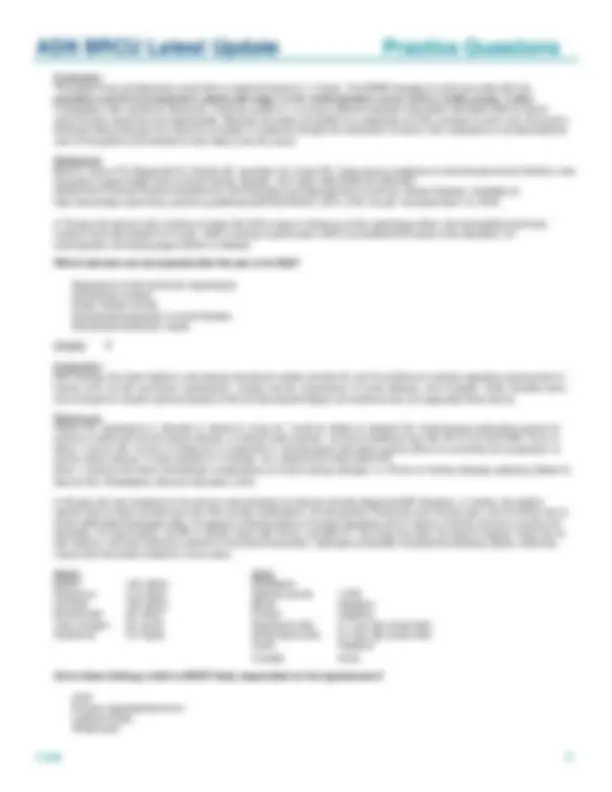
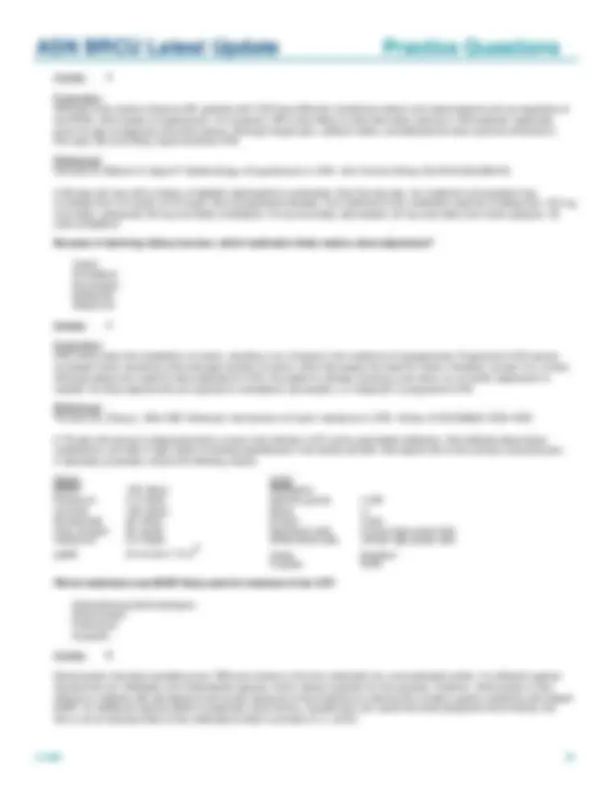
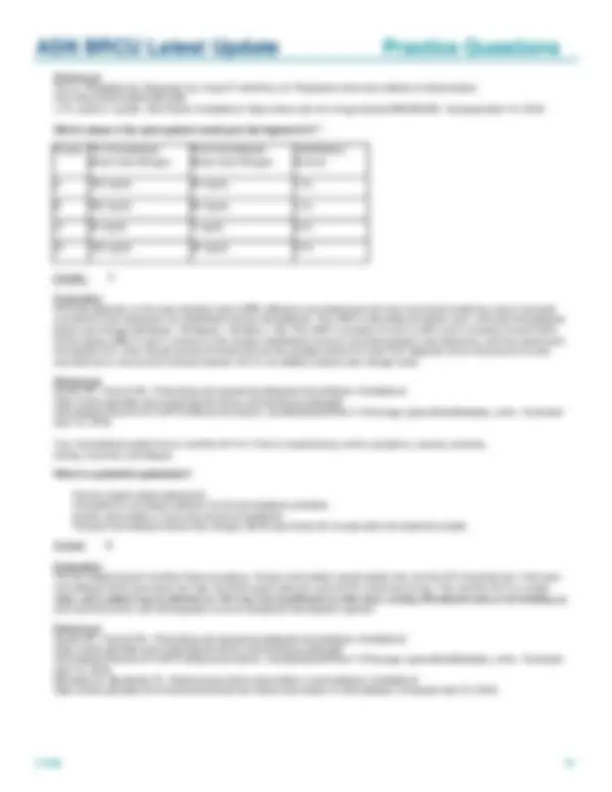
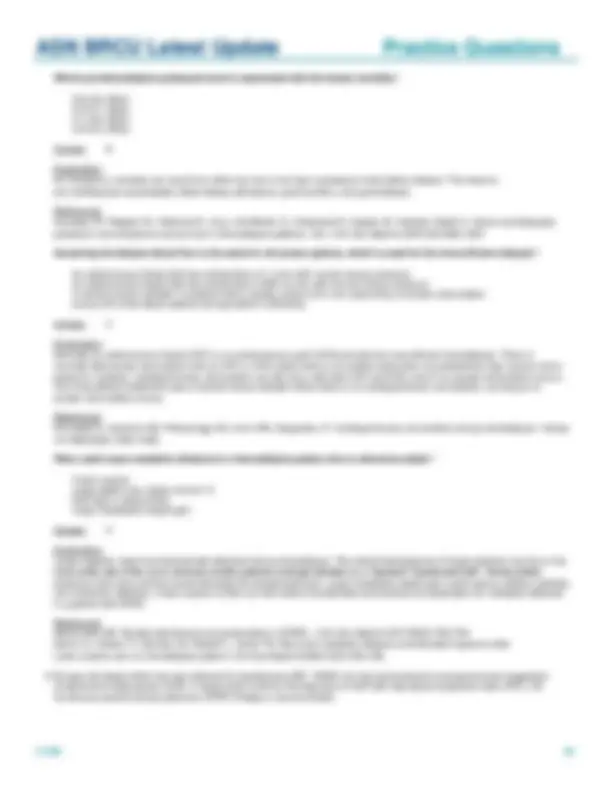
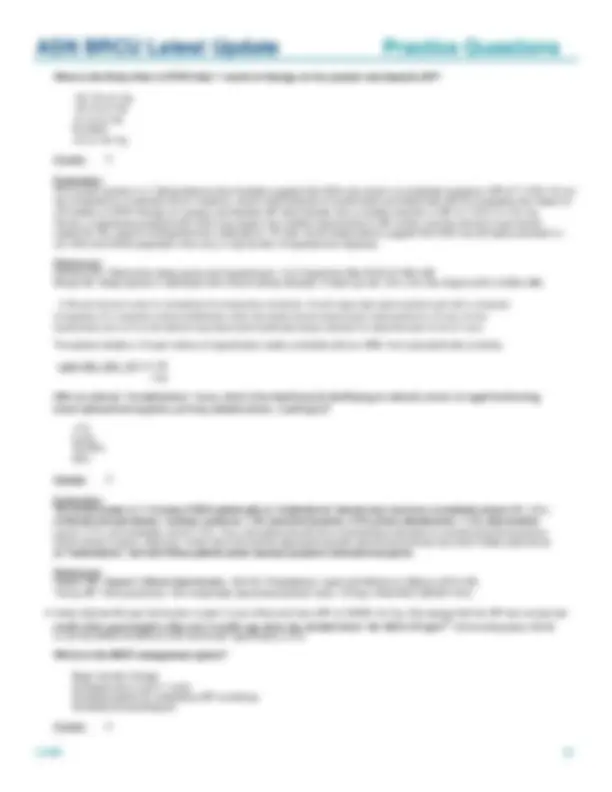
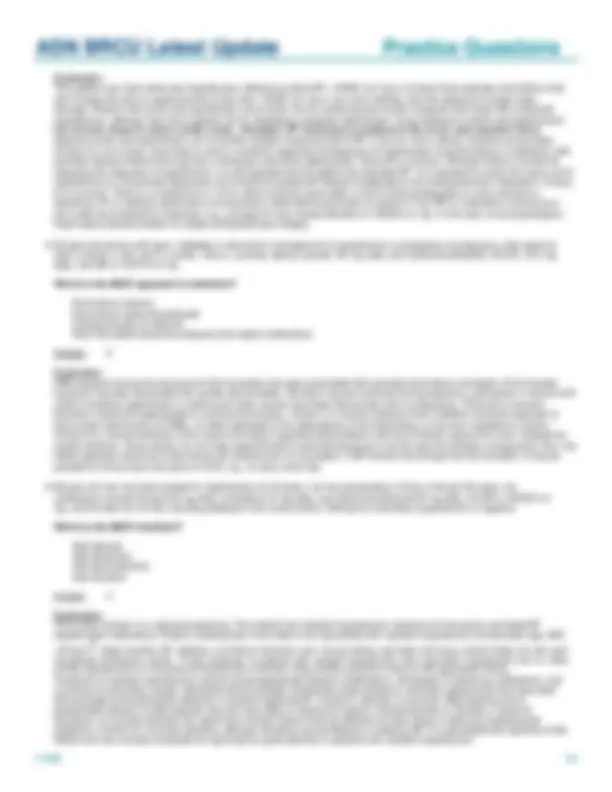
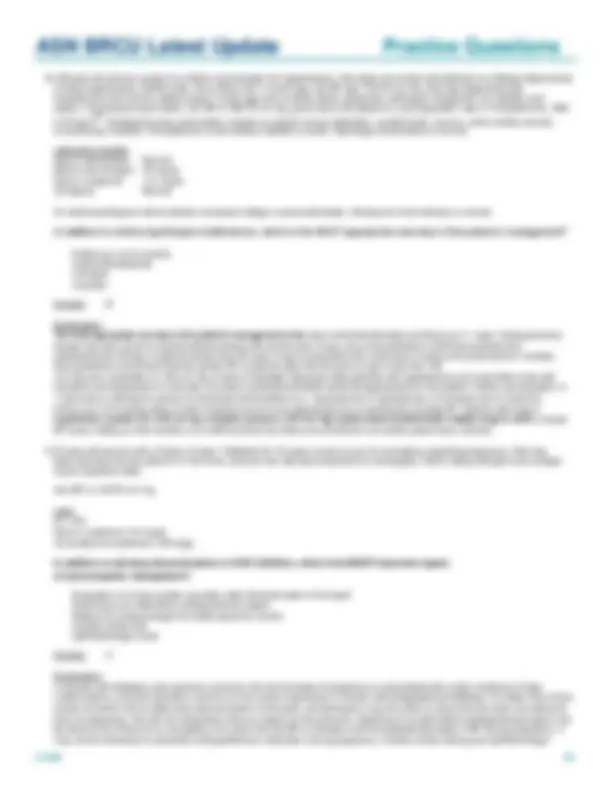
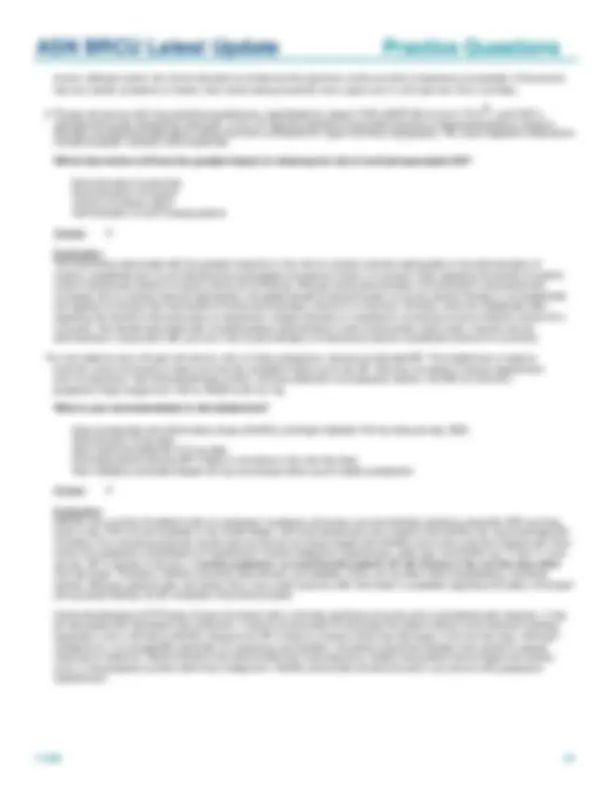
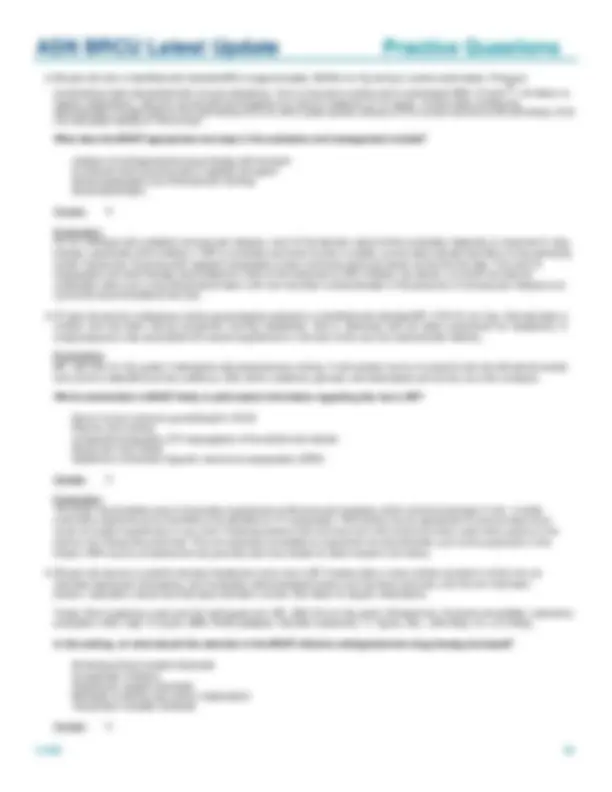
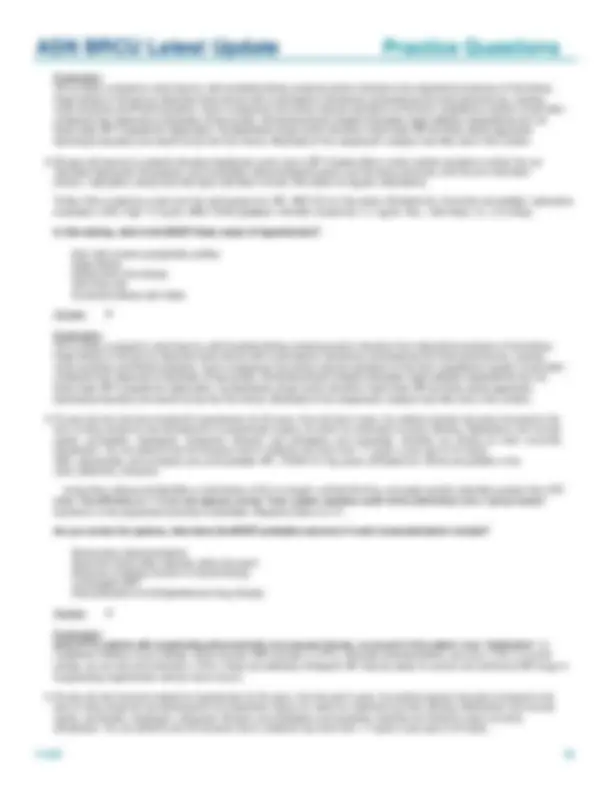
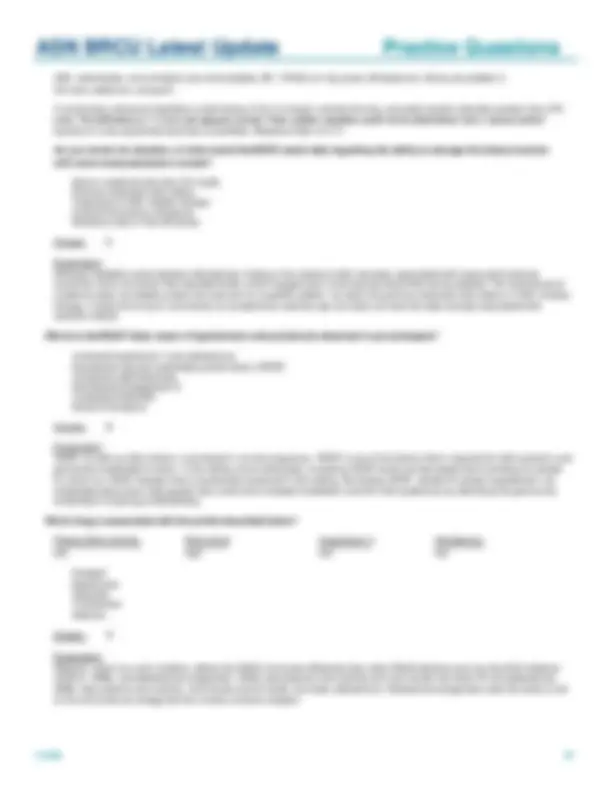
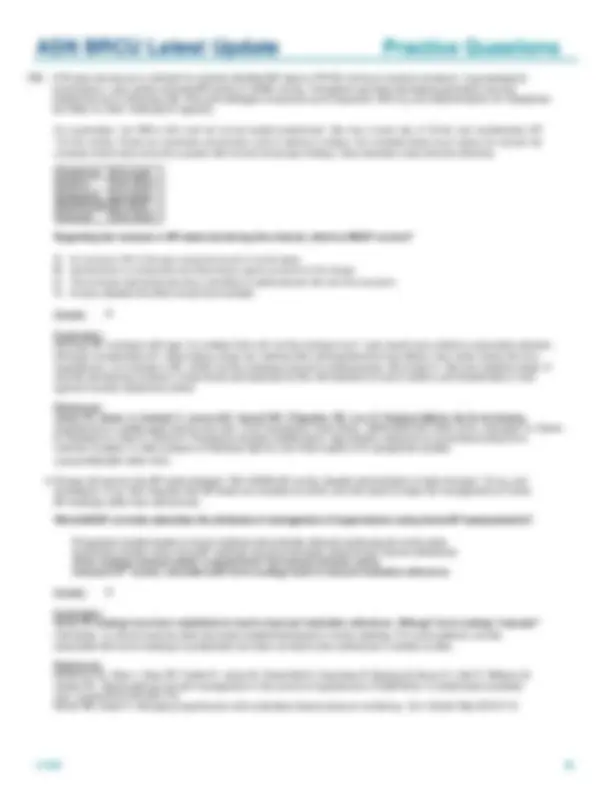
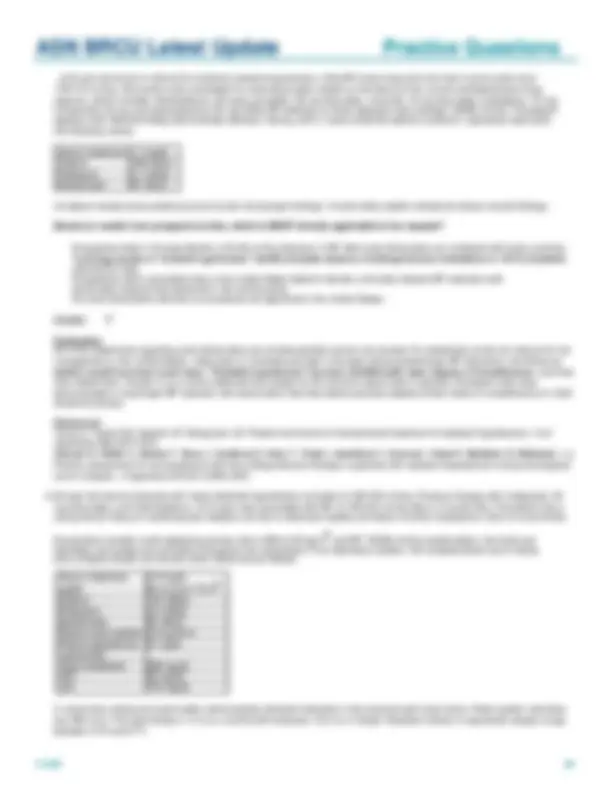
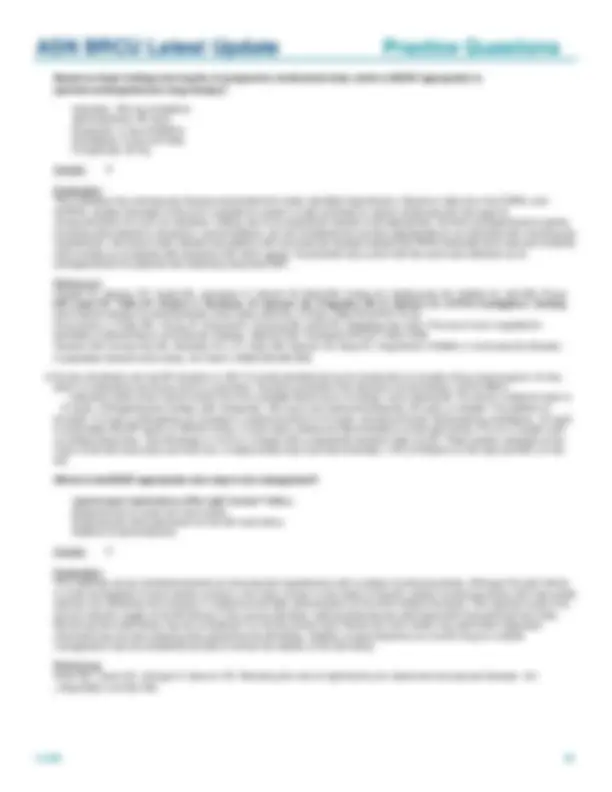

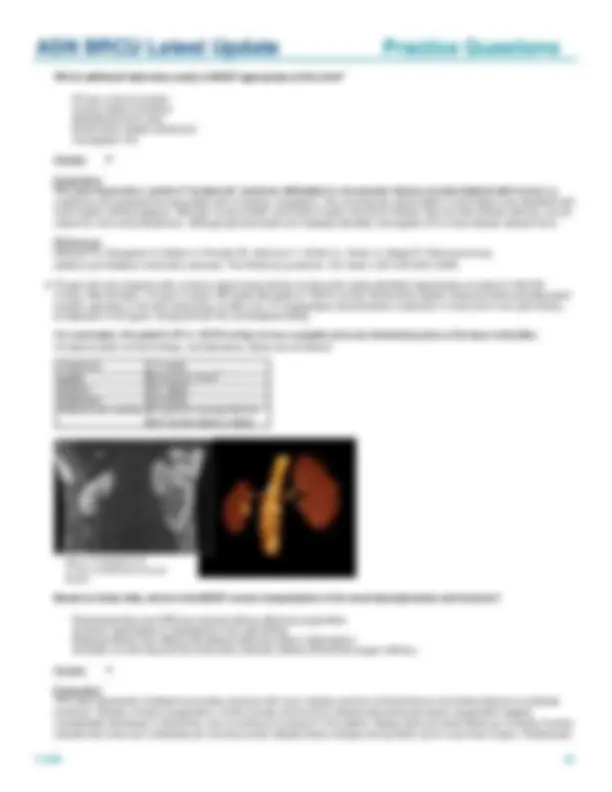
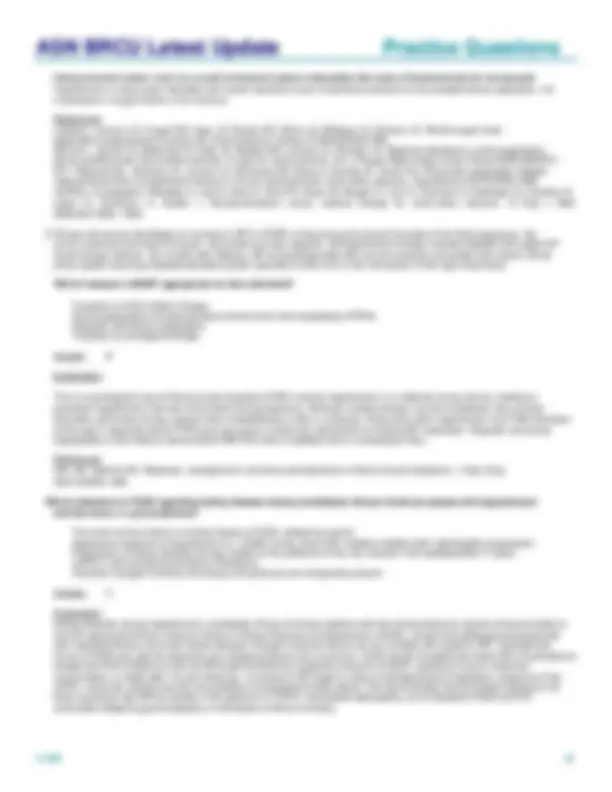
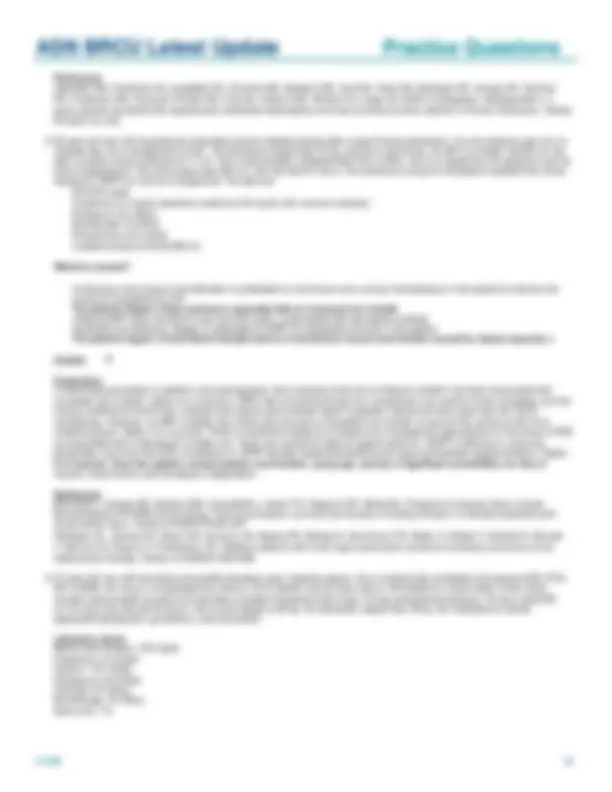
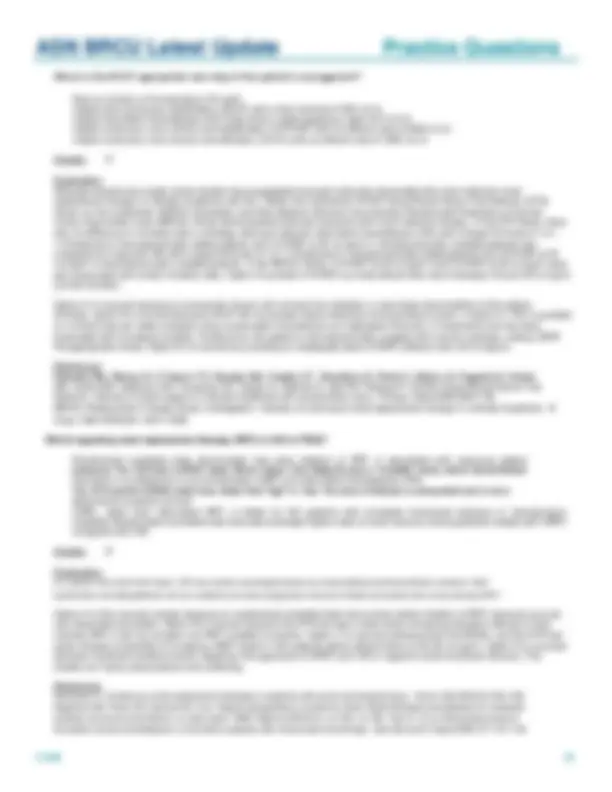
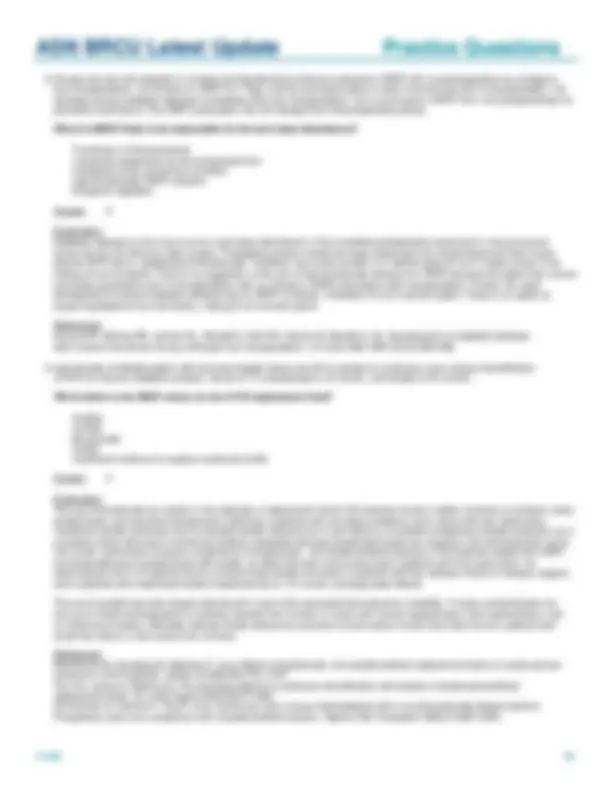
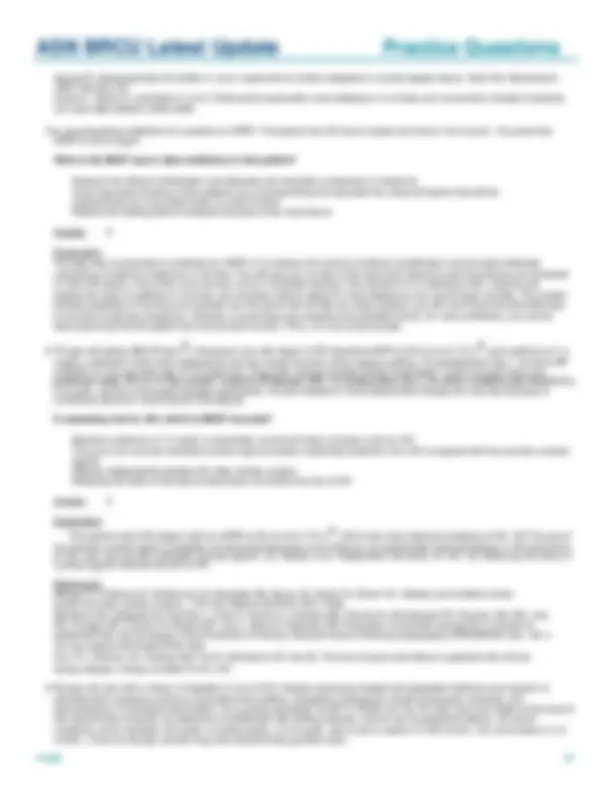


Study with the several resources on Docsity

Earn points by helping other students or get them with a premium plan


Prepare for your exams
Study with the several resources on Docsity

Earn points to download
Earn points by helping other students or get them with a premium plan
Community
Ask the community for help and clear up your study doubts
Discover the best universities in your country according to Docsity users
Free resources
Download our free guides on studying techniques, anxiety management strategies, and thesis advice from Docsity tutors
ASN BRCU Practice Questions and Answers Latest Update.
Typology: Exams
1 / 300

This page cannot be seen from the preview
Don't miss anything!





























































































An 18-year-old white man presents to your office after developing gross hematuria. Your physical examination reveals some papules on his face and neck. They are 1–3 mm in size and are nontender. BP is normal, and serum creatinine is 1.2. Urinalysis reveals a pattern of uniformly shaped red blood cells in greater than 100 cells per high power field. The patient has completed high school, but he was known as a very slow learner and a poor student. Imaging of his kidneys reveals some cystic change in both kidneys and a solid-looking vascular mass in the right kidney. What is the MOST likely diagnosis? Renal cell carcinoma ADPKD Autosomal recessive PKD Tuberous sclerosis Von Hippel-Lindau syndrome Answer: D Explanation: The patient described has the skin lesions and renal findings of tuberous sclerosis. The renal lesions are typically angiomyolipomas and can bleed. Although mental retardation is common in this autosomal dominant disorder, it is not inevitable. Von Hippel-Lindau syndrome is a possibility based on the renal finding, but this would not explain the skin lesions. ADPKD is unlikely with this imaging picture and again would not explain the skin lesions. A renal cell carcinoma is possible but at his age is unlikely and is unaccompanied by some genetic syndrome with skin lesions. On ultrasound images, the normal kidney should have which characteristic? Larger than 14 cm in length Have wedge-shaped areas of low blood flow in the cortex on Power Doppler Be equal or less echogenic than the liver Have symmetric bilateral effacement of the renal sinus echo-complex with dilated calyces Answer: C Explanation: The echogenicity of normal kidneys is less than that of pancreas and equal or less than that of liver and spleen. Increased renal echogenicity indicates renal disease. Normal kidneys measure 9–13 cm on ultrasound exams; A is incorrect. Normal kidneys have no low flow areas on Doppler exams, and wedge-shaped deficiencies are indicative of infarcts; B is incorrect. Dilated calyces should not be present in normal kidneys, and these suggest obstruction or ectasia from prior disease; D is incorrect. A 49-year-old morbidly obese man with a history of hypertension (HTN), metabolic syndrome, osteoarthritis, and gout undergoes a Roux-en-Y bypass procedure. Medications include lisinopril, furosemide, ibuprofen, and glyburide. The patient presents 4.5 weeks later with weakness and fatigue. Labs reveal a serum creatinine of 3.7 mg/dL. Urine sediment demonstrates 1–3 RBCs/HPF, 0–1 WBCs/HPF, 2–5 renal tubular cells/HPF, and the crystals seen in the figure. Which BEST describes the crystals?
alcium phosphate crystals
ric acid crystals
ystine crystals
alcium oxalate crystals
ulfonamide crystals Answer: D Explanation: The patient developed kidney injury after the gastric bypass procedure. The urine microscopy reveals calcium oxalate crystals, which reflect the enteric hyperoxaluria that has developed following the malabsorption induced by the weight loss procedure.
With fat malabsorption, calcium is saponified by the fat, allowing free oxalate to be reabsorbed. This leads to increased serum oxalate with subsequent hyperoxaluria and acute oxalate nephropathy. The other crystals are incorrect.
Which statement is TRUE about women who donate a kidney before becoming pregnant? They are at increased risk for progression of kidney disease postpartum. They are at increased risk for adverse outcomes during pregnancy including preeclampsia. They are NOT at increased risk for adverse outcomes during or after pregnancy if their kidney function is normal and they have no proteinuria. They are at increased risk for progression of kidney disease but not adverse outcomes during pregnancy. Answer: B Explanation: Kidney donation is associated with increased risk for adverse outcomes DURING pregnancy. The other answers are incorrect and not observed in the described scenarios. References: Garg AX, Nevis IF, McArthur E, Sontrop JM, Koval JJ, Lam NN, Hildebrand AM, Reese PP, Storsley L, Gill JS, Segev DL, Habbous S, Bugeja A, Knoll GA, Dipchand C, Monroy-Cuadros M, Lentine KL; DONOR Network. Gestational hypertension and preeclampsia in living kidney donors. N Engl J Med 372:124–133,2015. Which statement is TRUE about the use of ACE inhibitors during pregnancy? Contraindicated, but only in the second and third trimesters. Contraindicated, but only in the first trimester. Contraindicated, but they can be used during breastfeeding postpartum. Contraindicated, they are contraindicated during pregnancy and during breastfeeding. Answer: C Explanation: ACE inhibitors are contraindicated during pregnancy but can be used in the postpartum period during infant breastfeeding. References: Cooper WO, Hernandez-Diaz S, Arbogast PG, Dudley JA, Dyer S, Gideon PS, Hall K, Ray WA. Major congenital malformations after first-trimester exposure to ACE inhibitors. N Engl J Med 2006;354:2443–2451. A 50-year-old man was admitted to the hospital with abdominal pain and AKI. A subsequent workup demonstrated the presence of acute pancreatitis, and an abdominal computerized tomography (CT) scan showed multiple renal mass lesions. A kidney biopsy revealed an extensive plasma cell infiltrate. Laboratory results C3: 65 (nl >80 IU) Anti–nuclear antibody (ANA): positive 1: C4: 15 (nl >20 IU) WBC: 8500 with 10% eosinophilia Based on this patient’s clinical presentation, what is the MOST likely diagnosis? Sarcoidosis with multiple renal granuloma Myeloma with renal plasmacytomas IgG4-related systemic disease Systemic lupus erythematosus (SLE) with systemic vasculitis Undocumented drug ingestion causing acute allergic interstitial nephritis Answer: C Explanation: This patient presents with IgG4-related systemic disease. It is characterized by a marked plasma cell infiltrate (typically described in a “storiform” cartwheel pattern) that produces expansile destructive lesions. Autoimmune pancreatitis is frequently seen in conjunction with renal disease, but all major organs may demonstrate variable involvement. IgG4 is uniquely deposited in the tubules. The classical complement pathway may be activated with a resultant low C3 and C4, and there may eosinophilia and low- grade ANA titers. A tubulointerstitial nephritis and/or membranous nephropathy is typically seen in the kidney, but obstruction can also occur from the large plasma cell aggregates. Sarcoid and myeloma do not activate complement, nor does acute interstitial nephritis (AIN). None of the other choices are associated with the systemic and laboratory presentation of IgG4-related systemic disease.
A 38-year-old morbidly obese woman with a history of CKD, hypertension, osteoarthritis, metabolic syndrome, and gout is started on orlistat 120 mg bid and increased to 120 mg tid (after 1 month) for enhanced weight loss. Medications include enalapril, orlistat, hydrochlorothiazide (HCTZ), naproxen, and glyburide. The patient presents 5.5 weeks later with anorexia, nausea, weakness, and fatigue. She describes 9 days of an exquisitely tender left foot and ankle that are swollen and erythematous. At the time of presentation, she is finishing a 7-day course of trimethoprim-sulfamethoxazole for a urinary tract infection (UTI). Serum creatinine is 3.7 mg/dL (baseline, 1.6 mg/dL). Urine sediment demonstrates red blood cells, white blood cells, renal tubular cells, and a few crystals. A kidney biopsy is performed, and the image is shown under polarization. Which crystal is seen within the renal tubular lumens on renal biopsy? Calcium phosphate crystals Uric acid crystals Calcium oxalate crystals Sulfonamide crystals Answer: C Explanation: The patient developed renal failure in the setting of fat malabsorption induced by the weight loss drug orlistat. The urine microscopy reveals calcium oxalate crystals, which reflect the enteric hyperoxaluria that has developed following the malabsorption induced by orlistat. With fat malabsorption, calcium is saponified by the malabsorbed fat, allowing free oxalate to be reabsorbed; this leads to increased serum oxalate with subsequent hyperoxaluria and acute oxalate nephropathy. In the kidney biopsy, calcium oxalate crystals, which polarize positively, are seen within the tubular lumens and are the cause of the AKI. Orlistat is the cause by its mechanism to induce malabsorption. The other options are incorrect as they do not cause acute oxalate nephropathy. A 50-year-old white man has been working in a foundry as a welder for many years. He now presents with an elevated creatinine of 2.3 mg/dL and a urine protein/creatinine ratio of 1.2. There are no old records except for the following information: Medical history is positive for hypertension and gout. Smoking history is negative. Renal ultrasound: slightly echogenic but normal size kidneys bilaterally/no stones. EKG: Minimal voltage criteria for left ventricular hypertrophy (LVH). Urinalysis Specific gravity: 1. Blood: 0–2 per high power field WBC: 0–2 per high power field Protein: 1+ What is your assessment? Patient has unrecognized hypertensive nephropathy Patient has beryllium nephropathy Patient has cadmium nephropathy Patient has lead nephropathy Patient has mercury nephropathy Answer: D Explanation: Working in a foundry, exposure to heavy metals is a strong consideration (option B or D). The patient could have hypertension nephrosclerosis; but he is Caucasian, and the EKG shows minimal evidence for LVH which would be unlikely in hypertension- induced nephrosclerosis. Cadmium exposure is more likely in a battery plant and has other associations such as bone disease and stones. Cadmium is a well-known cause of hypertension and CKD and gives a picture of chronic tubulointerstitial nephritis with non-nephritic proteinuria and bland urine sediment similar to lead nephropathy but is not associated with gout. Chronic lead toxicity classically has been associated with the triad of gout, hypertension, and CKD, which this patient has. The history for mercury and beryllium toxicity is the wrong environmental exposure. A Chinese patient presented with advanced CKD. No kidney biopsy was performed, but by history, the patient routinely used a variety of Chinese herbs for health and weight loss. He underwent a successful one-haplotype pre-emptive living related transplant from his sister using induction therapy with an IL-2 blocker. Tacrolimus and mycophenolate were used as maintenance immunosuppression with a steroid-free protocol. After 12 months, he now presents with painless gross hematuria but otherwise is afebrile and feeling well.
Which statement about heavy metal and nonsteroidal anti-inflammatory drug (NSAID) nephrotoxicity is TRUE? Lead affects the proximal tubule due to the presence of organic anion transporters in this segment Cadmium affects the distal tubule, leading to type I renal tubular acidosis (RTA) Gold therapy may result in nephrotic syndrome due to the development of minimal change disease NSAIDs may cause nephrotic syndrome due to minimal change disease Platinum-containing chemotherapy agents may cause AKI most commonly from acute interstitial nephritis Answer: D Explanation: NSAIDs cause a unique type of nephrotoxicity characterized by nephrotic range proteinuria with or without AKI from AIN; but when AIN is also present, it is usually without typical AIN coexistent findings of eosinophilia, rash, or fever. The glomerular histology is that of minimal change disease that resolves within weeks of stopping the medication (option D). Lead is a cation, and the organic cation transport (OCT) system (not the organic anion transporter) in the proximal tubule is vital for its absorption and toxicity. Cadmium affects the proximal tubule, and gold causes nephrotic syndrome from membranous disease and not minimal change lesions. Platinum compounds cause acute tubular necrosis (ATN) through both apoptosis and necrosis, especially of the proximal tubule, and do not cause interstitial nephritis. A 28-year-old retired army captain who is otherwise healthy presents with right-sided renal colic. He passed a stone spontaneously but failed to retrieve it. The rest of the history was negative, including family history. He is very active in body building, with daily visits to the gym. Physical examination showed a very muscular young white man with no abnormal findings. A computed tomography (CT) scan that was performed after his renal colic showed a radio-opaque 3-mm stone in the left renal pelvis. Plasma chemistry was entirely normal. A 24-hour urine analysis showed the following: Volume: 1.7 L/day K: 30 mEq/day Ca: 300 mg/day P: 1120 mg/day Oxalate: 25 mg/day Mg: 65 mg/day Uric acid: 760 mg/day SO 4 : 40 mmol/day Citrate: 82 mg/day NH 4 : 72 mEq/day pH: 5.6 Creatinine: 2000 mg Na: 240 mEq/day Parameter Desired value to reduce relative stone risk Ca <250 mg/day Ox <45 mg/day Uric acid <700 mg/day Citrate >320 mg/day pH 5.5–7. TV >2 L/day Na <200 mEq/day K >50 mEq/day SO 4 <30 mmol/day P <1100 mg/day Mg >60 mg/day Cl <200 mEq/day NH 4 <45 mEq/day Which is NOT correct about this patient? Both the hypercalciuria and hypocitraturia are conferring increased risk for kidney stones The hyperuricemia and hyperphosphaturia are minor contributors to the stone risk The hypocitraturia is most likely physiologic in response to acid loading The high sulfate and low urine pH are promoting calcium oxalate precipitation There is likely a dietary component to the hypercalciuria Answer: D Explanation: Options A, B, C, and E are correct statements and therefore NOT the correct answer. The stone risk is increased by either and compounded by both hypercalciuria and hypocitraturia. Although hyperuricosuria can increase the risk of calcium oxalate stones and hyperphosphaturia can increase the risk of calcium phosphate stones, they are very mild in this case and contribute relatively very little. Citrate is a major base in the urine and will decrease in response to acid intake. The hypercalciuria is most likely
secondary to high dietary sodium and acid intake. Option D is not correct and therefore the answer is the high sulfate and low urine pH are markers for high acid intake and by themselves do not promote calcium oxalate precipitation. You are asked to evaluate a 45-year-old white woman who has a history of recurrent renal colic. Multiple stones are visible on sonogram, but the plain abdominal x-ray is completely negative. There are no stone analyses on record, but ample uric acid crystals were noted on urinalysis. History is positive for primary hypertension controlled on an ACE inhibitor, hypercholesterolemia treated with simvastatin, and type 2 diabetes treated with metformin and a sulfonylurea. Physical exam reviews an obese female with a body mass index of 35 kg/m 2
. There is no evidence of tophi. The rest of the exam is noncontributory other than obesity. Routine chemistry is within normal limits except for a fasting glucose of 115 mg/dL. Her hemoglobin A1C is 6.7%. Total cholesterol is 180 mg/dL, with LDL of 105 mg/dL. A 24-hour urine analysis showed the following: Volume: 2.2 L/day K: 72 mEq/day Ca: 143 mg/day P: 970 mg/day Oxalate: 20 mg/day Mg: 70 mg/day Uric acid: 690 mg/day SO 4 : 10 mmol/day Citrate: 310 mg/day NH 4 : 32 mEq/day pH: 5.0 Net acid: 80 mEq/day Na: 135 mEq/day Creatinine: 880 mg/day Parameter Desired value to reduce relative stone risk Ca <250 mg/day Ox <45 mg/day Uric acid <700 mg/day Citrate >320 mg/day pH 5.5–7. TV >2 L/day Na <200 mEq/day K >50 mEq/day SO 4 <30 mmol/day P <1100 mg/day Mg >60 mg/day Cl <200 mEq/day NH 4 <45 mEq/day Beware that there are really no true normal values for 24-hour urine. In zero balance state, addition to the body equals output, so the “normal” excretion is what was added to the organism. Which is MOST correct about this patient? She likely has a uric acid stone from high uric acid excretion due to high purine ingestion Uric acid crystals are diagnostic of uric acid stones The singular most important pathogenic factor is low urine pH A major pathogenic factor is high dietary acid intake Urolithiasis is occurring as an incidental finding that is not related to her metabolic syndrome Answer: C Explanation: Her 24-hour uric acid excretion is not very high, and even if it is, it is difficult to infer high dietary purine intake on the basis of hyperuricosuria alone (choice A not correct). Uric acid crystal can precipitate in the urine when the urine is concentrated or acidic; however, uric acid crystalluria per se is not diagnostic of uric acid stones (choice B not correct). High dietary acid intake can lower urine pH and is often seen in uric acid stone formers, but her sulfate excretion, which is the best marker for dietary acid intake, in fact is not high (choice D not correct). The low urine pH stems from complex systemic pathophysiologic disturbances including high acid generation and inability of the urine to buffer free H+. This is very commonly seen in the metabolic syndrome (choice E not correct). The low urine pH converts urate to the insoluble uric acid, which promotes precipitation and is therefore the most correct statement (choice C is correct). A 19-year-old woman is one of two siblings whose parents immigrated from a small village in a Middle Eastern country. She first presented with renal colic when she was 14 and had suffered from recurrent episodes of renal colic and hematuria. A recent plain x-ray showed two radio-opaque stones in the left kidney and one in the right kidney. Her parents are both healthy, and her older 21-year-old brother is also completely healthy. History is otherwise unremarkable other than the stones. Examination showed a slim 55-kg woman with no abnormal findings. Serum chemistry on several occasions is within normal limits.
Parameter Desired value to reduce relative stone risk Ca <250 mg/day Ox <45 mg/day Uric acid <700 mg/day Citrate >320 mg/day pH 5.5–7. TV >2 L/day Na <200 mEq/day K >50 mEq/day SO 4 <30 mmol/day P <1100 mg/day Mg >60 mg/day Cl <200 mEq/day NH 4 <45 mEq/day What is included in proper management of this condition? Dietary protein restriction aimed to elevated urine citrate Lowering the urine pH to 5. Allopurinol therapy Oral α-mercaptopropionylglycine Genetic counseling of the family D and E Answer: F Explanation: A higher urine pH (UpH) will help dissolve the cysteine. Dietary protein restriction may help elevate UpH. However, the urinary citrate is a little low, but this is not a risk for stone formation in this case. Also, the dietary protein intake is not particularly high. Both fluid intake and higher urine pH will help dissolve cysteine. Quantitation of urine cysteine will confirm the diagnosis of cystinuria, and the urinary level is useful in following the patient’s response to treatment. Remember that this is not part of the routine stone risk profile. α-Mercaptopropionylglycine improves solubilization of cysteine. This is an autosomal recessive disease, and the family needs to be educated. A 56-year-old man with morbid obesity, type 2 diabetes, hypertension, and osteoarthritis underwent Roux-en-Y gastric bypass and successfully reduced his body mass index (BMI) from 37 to 28 kg/m 2
. His glycemic control is much improved, antihypertensive dosage reduced, and his osteoarthritis of the knee is virtually gone. While basking in this successful outcome, the clinical progress was disenchanted by a painful episode of renal colic. The patient is otherwise asymptomatic, and physical examination was negative. After spontaneous passage, a computed tomography (CT) scan of the kidney did not reveal any more stones. No stone analysis is available. Laboratory tests in the serum were all normal. A 24-hour urine showed the following: Volume: 1.4 L/day K: 47 mEq/day Ca: 90 mg/day P: 1070 mg/day Oxalate: 49 mg/day Mg: 56 mg/day Uric acid: 690 mg/day SO 4 : 15 mmol/day Citrate: 395 mg/day NH 4 : 32 mEq/day pH: 6.0 Creatinine: 1195 mg/day Na: 123 mEq/day Parameter Desired value to reduce relative stone risk Ca <250 mg/day Ox <45 mg/day Uric acid <700 mg/day Citrate >320 mg/day pH 5.5–7. TV >2 L/day Na <200 mEq/day K >50 mEq/day SO 4 <30 mmol/day P <1100 mg/day Mg >60 mg/day Cl <200 mEq/day NH 4 <45 mEq/day
Beware that there are really no true normal values for 24-hour urine. In zero balance state, addition to the body equals output, so the “normal” excretion is what was added to the organism. Which is MOST important for the increased stone risk in this patient? Volume depletion from intestinal Na malabsorption is a major contributor to the stone risk Intestinal bicarbonate wasting is driving a subclinical metabolic acidosis The metabolic syndrome, although improved, is still putting the patient at risk for uric acid stones Enteric hyperoxaluria from reduced secretion and increased absorption of oxalate in the intestine is increasing the stone risk Magnesium malabsorption in the gut is increasing the stone risk Answer: D Explanation: Enteric hyperoxaluria from reduced secretion and increased absorption of oxalate in the intestine is increasing the stone risk and is the most likely reason for increased stone risk (choice D is correct) There is usually not excessive amounts of fluid loss with gastric bypass. This patient’s urine volume is not very low (choice A not correct). Intestinal bicarbonate loss is not a prominent feature of gastric bypass. This patient clearly does not have low urine sodium and citrate, which are hallmarks of intestinal alkali loss (choice B not correct). A metabolic syndrome is perhaps a possibility but the urinary chemistry, particularly the urine pH, is not characteristic of uric acid urolithiasis. The other feature against this model is that the patient did not form stones before the bypass (choice C not correct) when his metabolic syndrome would have put him at a much higher risk. There is occasionally some degree of magnesium malabsorption with this surgical procedure, and low magnesium in the urine can confer some risk in stone formation, but this is not the most important stone risk in this patient (choice E not correct).
internist. After 10 days, the patient presents with clinical findings of an allergic interstitial nephritis. Which BEST describes what you would find in this patient? Choice Kidney size Skin rash Eosinophilia Nephrotic syndrome Kidney biopsy A Small Absent Present Absent Interstitial B cells and neutrophils B Large Present Present Absent Interstitial T cells C Large Absent Present Absent Interstitial B cells D Large Present Present Present Interstitial T cells E Normal Present Absent Absent Interstitial T cells neutrophils Answer: B Explanation: The classic presentation of a penicillin - or antibiotic-induced interstitial nephritis is the triad of a fever, rash, and eosinophilia. The kidneys are infiltrated by an extensive T-cell population indicating a type IV hypersensitivity etiology for the lesion. The T cells are predominantly CD8 in origin. In addition, there are scattered eosinophils, macrophages, and very rarely B cells. The typical patient has non-nephrotic range proteinuria unless the interstitial nephritis is due to nonsteroidal anti-inflammatory drugs (NSAIDs), when nephrotic syndrome may occur.
Answer: F Explanation: All of the listed diseases can be associated with granulomatous interstitial nephritis. In addition, tuberculosis (TB), Behcet’s, and most drugs that result in classic acute interstitial nephritis (AIN) can be associated with granulomas. The TINU syndrome is very important as a cause of simultaneous ocular and renal involvement.
Which MOST closely reflects the overall prevalence of biopsy-proven acute interstitial nephritis (AIN) in biopsies obtained for any clinical indication? 2 – 5% 5 – 10% 10 – 15% 15 – 20%
20% Answer: A Explanation: When examining the kidney biopsy registries of multiple institutions, the prevalence of AIN in these biopsies, obtained for any possible reason, is fairly consistent. The prevalence numbers generally fall between 2% and 5%, with a slight trend for more AIN in recent years. Which MOST closely reflects the prevalence of biopsy-proven acute interstitial nephritis (AIN) in patients with AKI? 5 – 10% 10 – 15% 15 – 20% 20 – 30% 30% Answer: B Explanation: In contrast to kidney biopsies obtained for any reason, the prevalence of AIN in biopsies obtained in the setting of AKI is higher. In this setting, AIN is seen in 10–15% of biopsies. Which is the MOST common cause of acute interstitial nephritis (AIN) in the United States? Sarcoidosis Tubulointerstitial nephritis with uveitis (TINU) Medications Viral infections Sjogren syndrome IgG4 disease Answer: C Explanation: In the United States and Europe, medications are far and away the most common cause of AIN. Greater than 70% of AIN in developed countries is due to drugs. In contrast, in developing countries, 50% is due to drugs, and 50% is due to infection. The other listed causes make up only a small percentage of the prevalence. In the published literature, which drugs are MOST commonly associated with acute interstitial nephritis (AIN)? Nonsteroidal anti-inflammatory drugs (NSAIDs) Antimicrobials Anticonvulsants H2 antagonists Chemotherapeutic agents Answer: B Explanation: Although PPIs are likely the overall leading cause of drug-induced AIN based on their massive worldwide use, the drugs most often noted in the published literature as causing AIN are antimicrobial agents.
A 59 - year-old woman presents with fever, weight loss, and fatigue for a several-week duration despite broad-spectrum antibiotics. Exam reveals diffuse rash and palpable adenopathy. Severe eosinophilia and AKI are noted. U/A has 2+ proteinuria, 1+ LE. Urine microscopy reveals 6–10 WBCs and 1–5 RBCs/HPF and 2–3 WBC casts/LPF. She undergoes a positron emission tomography (PET) scan for concerns over malignancy when multiple lymph nodes, kidneys, and spleen light up. A kidney biopsy is performed and is shown. What is the likely cause of this clinical presentation and kidney lesion? Sarcoidosis with severe granulomatous interstitial nephritis Severe toxic kidney injury with cortical necrosis Drug rash, eosinophilia, systemic symptoms (DRESS) syndrome with granulomatous acute interstitial nephritis (AIN) Lymphomatous infiltration of the kidney Eosinophilic leukemia with renal infiltration Answer: C Explanation: The clinical scenario is confusing with multiple possibilities; however, the kidney biopsy is diagnostic, showing an inflammatory infiltrate with numerous eosinophils, lymphocytes, and macrophages, as well as granuloma. The diagnosis is eosinophilic AIN in the setting of DRESS. Sarcoidosis can have this renal histopathology, but the presence of fever, eosinophilia, and diffuse skin rash makes it less likely. This is not cortical necrosis on biopsy histopathology. Neither lymphoma nor leukemia cells are seen on biopsy. A 71-year-old woman with hypertension, chronic obstructive pulmonary disease (COPD), coronary artery disease (CAD), ischemic cardiomyopathy, anemia, and stage 3a CKD (Cr, 1.2 mg/dL) was admitted with left lower extremity cellulitis. Intravenous fluids and intravenous piperacillin/tazobactam were administered. On day 8, the patient develops a rising serum creatinine. In this clinical setting, which will be the MOST diagnostic of drug-induced acute interstitial nephritis (AIN) in this patient? Clinical history with morbilliform rash and fever Sterile leukocyturia and WBC casts Urine eosinophils >5% Large echogenic kidneys on renal ultrasound Gallium scan positive at 48–72 hours Kidney biopsy showing an inflammatory interstitial infiltrate Answer: F Explanation: Clinical history, laboratory findings (including urine microscopy and possibly urine eosinophils), and imaging modalities are all nonspecific and insensitive for the diagnosis of drug-induced AIN. Thus, kidney biopsy demonstrating characteristic histopathology is required to definitively diagnose AIN. A 62-year-old man with coronary artery disease (CAD), hypertension, and type 2 diabetes mellitus (T2 DM) is hospitalized for methicillin-resistant Staphylococcus aureus (MRSA) cellulitis of the left leg. Intravenous piperacillin/tazobactam is administered. On day 12 of antibiotics, serum creatinine is noted to increase to 1.9 mg/dL (baseline, 1.1 mg/dL). Kidney function continues to decline over the next 3 days, with serum creatinine increasing to 3.9 mg/dL. Urine microscopy reveals 5–10 RBCs/HPF and 15– 20 WBCs/HPF. Urine protein/Cr is 0.74. Renal U/S: bilateral 11-cm echogenic kidneys without hydronephrosis. Kidney biopsy reveals patchy interstitial infiltrate consisting of lymphocytes, plasma cells, and eosinophils, as well as tubulitis, consistent with acute interstitial nephritis (AIN). In this patient, which is associated with an increased likelihood that kidney function will improve following a course of steroid therapy? Peak serum creatinine concentration <6 mg/dL Patchy versus diffuse interstitial infiltrate on kidney biopsy Steroid therapy initiated within 1 week of diagnosis Preserved kidney size on ultrasonography
Proteinuria <1 g/day Answer: C
Labs: Na, 142 mEq/L; K, 5.3 mEq/L; HCO 3 , 18 mEq/L; BUN, 56 mg/dL; sCr, 5.5 mg/dL. Urinalysis: specific gravity, 1004; 1+ pro; 1+ LE; and 1+ blood. Urine microscopy: 5–10 WBCs and 3–5 RBCs/HPF, 1–3 granular casts, and 0–1 WBC casts/LPF. A kidney biopsy is obtained. What is the MOST likely diagnosis in this clinical setting? Sjögren’s syndrome with acute interstitial nephritis (AIN) Sarcoidosis with AIN Tubulointerstitial nephritis and uveitis (TINU) Viral syndrome with associated AIN Nonsteroidal anti-inflammatory drug (NSAID)-associated systemic reaction with associated AIN Answer: B Explanation: The clinical scenario with pulmonary, eye, skin, and renal involvement, along with the renal biopsy findings of a cellular infiltrate and granuloma, make sarcoidosis the most likely diagnosis. Sjögren’s syndrome usually has eye and kidney involvement (without granuloma) but lacks some of the other signs and symptoms seen in this patient. TINU also has eye and skin involvement, but the eye finding is uveitis. There are no skin or pulmonary findings. Drugs and viruses are also not likely to cause this extensive of a clinical picture. A 61-year-old woman is evaluated for persistent dry cough (despite two different courses of oral antibiotics), malaise, fatigue, low- grade fever, and abdominal pain. Labs reveal the following: WBC, 11.3; Hb, 10.1; Cr, 1.5; and 5–10 WBCs/HPF on urine microscopy. A computed tomography (CT) scan of the chest is performed and shows a left upper lobe infiltrate/mass. A CT scan of the abdomen, performed for abdominal pain, is shown. The lung mass was biopsied and read as “lymphoplasmacytic infiltrate with reactive changes.” No evidence for cancer with numerous lymphocytes (T and B cells) and plasma cells. A kidney biopsy was obtained to make a definitive diagnosis.
What is the MOST likely diagnosis in this patient? T-cell lymphoma IgG4 related disease Sarcoidosis Castleman’s disease Eosinophilic granulomatosis with polyangiitis Answer: B Explanation: The clinical scenario of malaise, fatigue, low-grade fever, and pulmonary and renal masses noted on imaging and the lymphoplasmacytic infiltrate in lung and kidney tissue makes the diagnosis of IgG4 related disease highly likely. The other diagnoses have different histopathology. A 61-year-old woman is evaluated for persistent dry cough (despite two different courses of oral antibiotics), malaise, fatigue, low- grade fever, and abdominal pain. Labs reveal the following: WBC, 11.3; Hb, 10.1; Cr, 1.5; and 5–10 WBCs/HPF on urine microscopy. A computed tomography (CT) scan of the chest is performed and shows a left upper lobe infiltrate/mass. A CT scan of the abdomen, performed for abdominal pain, is shown. The lung mass was biopsied and read as “lymphoplasmacytic infiltrate with reactive changes.” No evidence for cancer with numerous lymphocytes (T and B cells) and plasma cells. A kidney biopsy was obtained to make a definitive diagnosis. What is the MOST appropriate treatment for this patient? Methotrexate and dexamethasone Cyclophosphamide and corticosteroids Corticosteroids alone Mycophenolic acid and corticosteroids No therapy is required at this time Answer: C Explanation: IgG4 is highly responsive to steroids alone. At times, the disease will relapse as steroids are tapered or withdrawn, requiring another course of therapy. Rituximab can be very useful for recurrent disease. A 55-year-old woman with Chronic Obstructive Pulmonary Disease (COPD), hypertension, congestive heart failure (CHF), osteoarthritis, and type 2 diabetes mellitus (T2 DM) presents with progressively worsening weakness. She describes having difficulty getting from the seated to standing position. Medications include inhalers, losartan/hydrochlorothiazide (HCTZ), metformin, carvedilol, naproxen, and aspirin. Vital signs are within normal range. Exam is pertinent for basilar lung crackles, S gallop, 1+ ankle edema, and 4/5 muscle weakness.
What is the diagnosis of this renal lesion? Light chain cast nephropathy Acute uric acid nephropathy Acute nephrocalcinosis (calcium-phosphate deposition) Acute granulomatous interstitial nephritis Acute infiltrative interstitial nephritis Answer: A Explanation: Light chain cast nephropathy associated with multiple myeloma is correct. The clinical presentation and histology with fractured, glassy casts with associated interstitial reaction/giant cell formation (engulfing casts) are diagnostic of cast nephropathy. Acute uric acid nephropathy from tumor lysis syndrome is incorrect as the clinical presentation and renal histology are not consistent. Acute nephrocalcinosis from calcium-phosphate deposition is possible from the high Ca-Phos product, but the histology is not consistent. Acute granulomatous interstitial nephritis from ibuprofen is possible, but the clinical presentation and lack of granuloma on histology are not consistent with drug-induced acute interstitial nephritis (AIN). Acute infiltrative interstitial nephritis occurs with lymphoma. However, although the kidneys are slightly enlarged, the renal histology does not demonstrate infiltration of the renal interstitium by lymphoma cells. A 57-year-old man is admitted with high fever, fatigue, and R>L flank pain. An exam reveals flank tenderness. AKI is noted with a sCr of 3.1 mg/dL. Urinalysis: specific gravity, 1.015; pH 6.0; 2+ protein; 2–4 RBCs/HPF; 5–10 WBCs/HPF, and 2– 3 macrophages/HPF. Urine culture grew Escherichia coli. Renal U/S is abnormal, prompting a magnetic resonance image (MRI). Nephrectomy is undertaken by urology after consultation with radiology and other medical services. The kidney histopathology is shown. What is the diagnosis in this patient? Xanthogranulomatous pyelonephritis (XGP) Emphysematous pyelonephritis Renal malacoplakia Renal cell cancer Chronic bacterial pyelonephritis Renal tuberculosis Answer: C Explanation: The clinical scenario of renal infection along with the MRI imaging findings and renal histopathology (foam cells with Michelis- Guttman bodies) are diagnostic of renal malacoplakia. Emphysematous pyelonephritis occurs from gas-forming organisms infecting the kidney and is associated with air in renal tissue on imaging and does not have the histopathologic findings noted in
this case. Renal cell cancer is not seen here on histopathology. Renal tuberculosis would have caseating granulomas in the renal parenchyma. XGP often has struvite stones with obstruction and lipid foam cells. In the dialysis unit, a 56-year-old woman who has been receiving dialysis for 3 years from diabetic nephropathy requests attention for a “rash” on her lower abdomen. The rash began as a series of purple nodules, which have now ulcerated and are quite tender. What is the MOST likely underlying pathology that would be noted on skin biopsy? Septal panniculitis Postcapillary venule neutrophilic infiltration Immune-complex deposition in the dermo-epidermal junction Proliferation of dermal fibroblasts, thickened collagen bundles, mucin deposition, and increased elastic fibers Answer: A Explanation: The skin lesion described is that of calcific uremic arteriolopathy. Its hallmark on skin biopsy is septal panniculitis. A 46-year-old African-American woman is referred because of detection of dipstick positive proteinuria. She is obese and has had a diagnosis of diabetes mellitus for the last 7 years. She also has moderately controlled hypertension and osteoarthritis. She smokes one pack of cigarettes per day but does not use other drugs or alcohol. Of note, her mother and one of her three siblings also have diabetes mellitus. Which is TRUE concerning this patient? Because she has only been diagnosed with diabetes mellitus for 7 years, her proteinuria is probably not due to diabetic nephropathy African-American women are the group at greatest risk for development of diabetic nephropathy Type 1 but not type 2 diabetic nephropathy demonstrates Mendelian inheritance Presence of two high-risk APOL1 alleles increases the risk of developing diabetic nephropathy Smoking and hypertension are both associated with an increased risk for progression of diabetic nephropathy Answer: E Explanation: Option A is false. Although patients with type 1 diabetes mellitus usually do not develop diabetic nephropathy (DN) until at least 10 years of disease, the time course in type 2 diabetics is more variable because the time of onset of disease may not be known, and even at initial presentation, a minority of patients with type II diabetes actually have overt nephropathy. Option B is false. African-American men have the greatest risk for development of DN. Option C is false. Although there is evidence for genetic predisposition, strict Mendelian inheritance has not been shown for either type 1 or type 2 DN. Option D is false. Although high- risk APOL1 alleles increase the risk of FSGS, hypertensive nephrosclerosis, and sickle nephropathy, it is not a risk factor for DN. Option E is true. Hypertension is well documented to increase progression of DN, and most studies have indicated an association of smoking to an increased progression of DN. References: Gall MA, Rossing P , Skott P, Damsbo P, Vaaq A, Bech K, Dejgaard A, Lauritzen M, Lauritzen E, Lougaard P, et al. Prevalence of micro- and macroalbuminuria, arterial hypertension, retinopathy and large vessel disease in European type 2 (non-insulin- dependent) diabetic patients. Diabetologia 1991;34(9):655–661. Pollak MR, Genovese G, Friedman DJ. APOL1 and kidney disease. Curr Opin Nephrol Hypertens 2012;21(2):179–182. Yacoub R, Habib H, Lahdo A, Al Ali R, Varjabedian L, Atalla G, Kassis Aki N, Aldakheel S, Alahdab S, Albitar S. Association between smoking and chronic kidney disease: A case control study. BMC Public Health 2010;10:731. A 16-year-old European-American man presents with nephrotic syndrome and normal kidney function. His physical exam is normal except for trace ankle edema. Idiopathic FSGS (lesion, not otherwise specified) is present on kidney biopsy. Despite a 6 - month course of oral high-dose steroids (with a statin and ACE inhibitor), proteinuria gradually increases from 4 to 8 g/day. Kidney function remains normal. The patient denies a family history of kidney disease, and there have not been consanguineous marriages in the family. Which genetic screening test is likely to detect a mutation in more than 5% of sporadic FSGS in adolescents? Mutations in the WT1 (Wilm’s Tumor 1) gene Mutations in the INF2 (inverted formin-2) gene Mutations in the NPHS2 (podocin) gene, including p.R229Q variant Mutations in the APOL1 (apolipoprotein L1) gene